Risk Management Assignment Contents
VerifiedAdded on 2021/05/31
|24
|4923
|123
AI Summary
The following table shows the outcome of the proposed project: Expected Outcome Targets for the Year Completion Progress at the year Completion Strengthening Livelihood of the rural people Reactivation Delivery Development plan for 60 village cooperative council and 125 new village cooperative council Implementation of the self-help program Providing social business for the development of 12, 950 men and women Indirect Benefit to around 14000 men and women Restoration plan for 52 community assets High progress have been seen in the development of village cooperative council i.e.
Contribute Materials
Your contribution can guide someone’s learning journey. Share your
documents today.
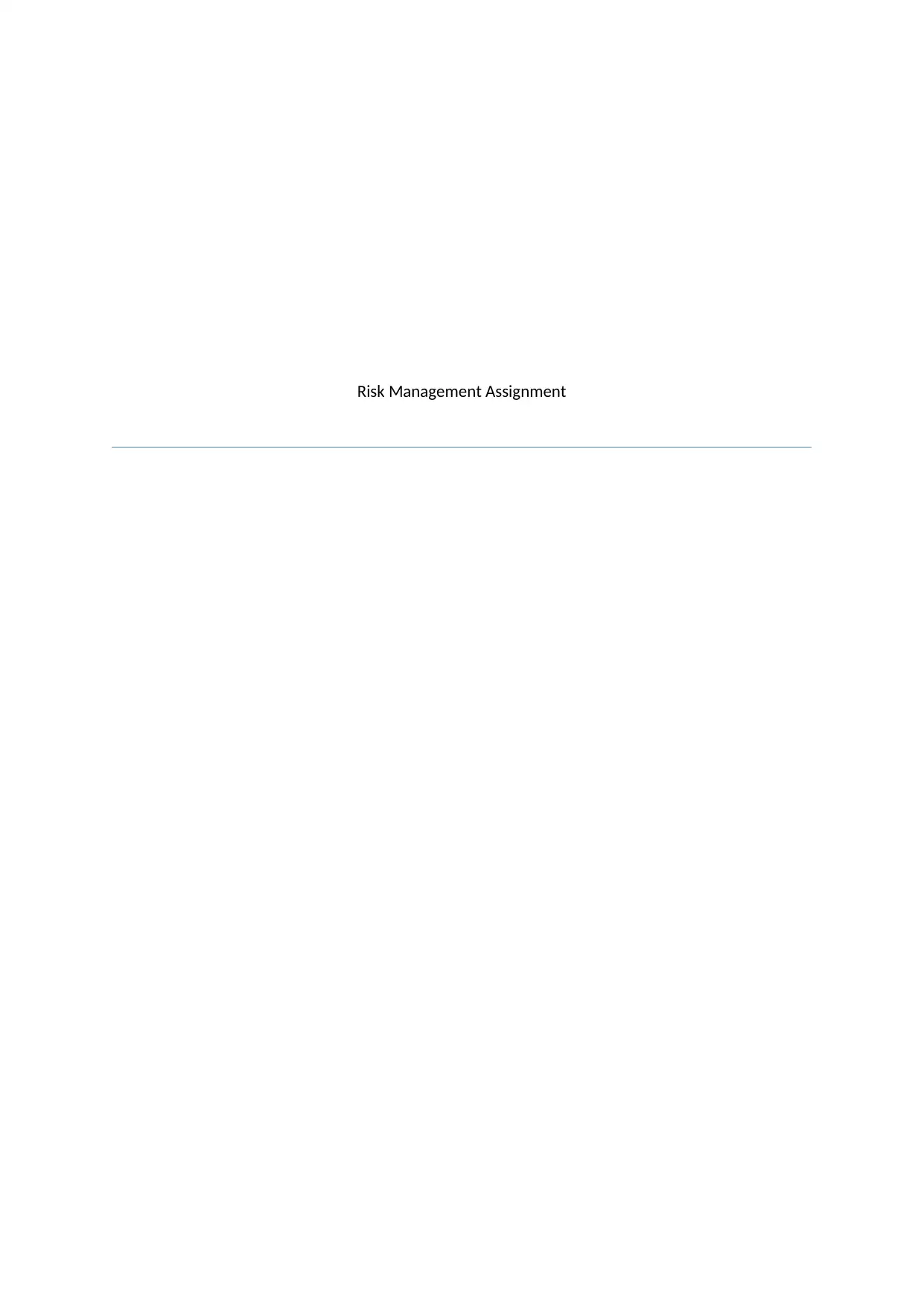
Risk Management Assignment
Secure Best Marks with AI Grader
Need help grading? Try our AI Grader for instant feedback on your assignments.
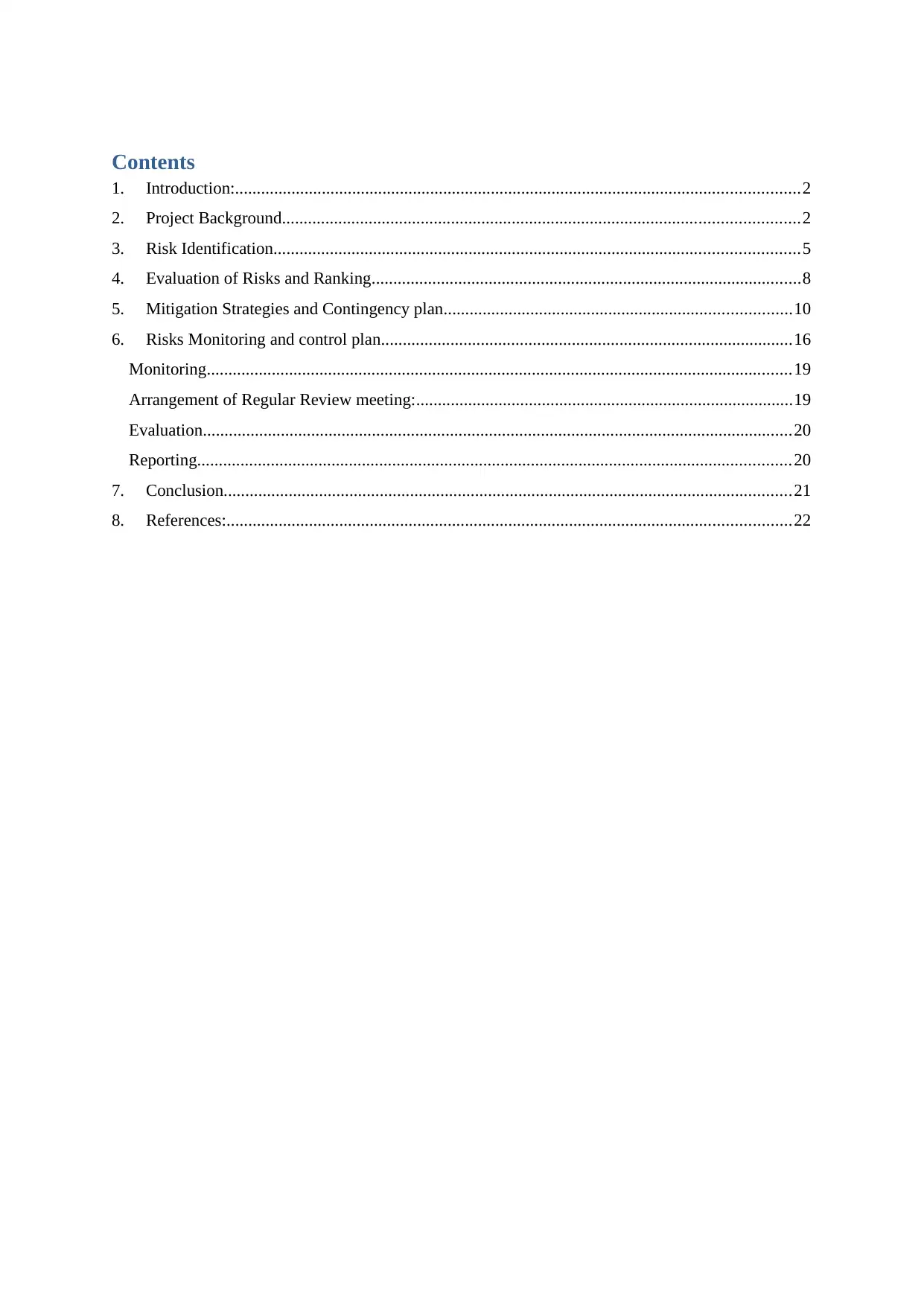
Contents
1. Introduction:..................................................................................................................................2
2. Project Background.......................................................................................................................2
3. Risk Identification.........................................................................................................................5
4. Evaluation of Risks and Ranking...................................................................................................8
5. Mitigation Strategies and Contingency plan................................................................................10
6. Risks Monitoring and control plan...............................................................................................16
Monitoring.......................................................................................................................................19
Arrangement of Regular Review meeting:.......................................................................................19
Evaluation........................................................................................................................................20
Reporting.........................................................................................................................................20
7. Conclusion...................................................................................................................................21
8. References:..................................................................................................................................22
1. Introduction:..................................................................................................................................2
2. Project Background.......................................................................................................................2
3. Risk Identification.........................................................................................................................5
4. Evaluation of Risks and Ranking...................................................................................................8
5. Mitigation Strategies and Contingency plan................................................................................10
6. Risks Monitoring and control plan...............................................................................................16
Monitoring.......................................................................................................................................19
Arrangement of Regular Review meeting:.......................................................................................19
Evaluation........................................................................................................................................20
Reporting.........................................................................................................................................20
7. Conclusion...................................................................................................................................21
8. References:..................................................................................................................................22
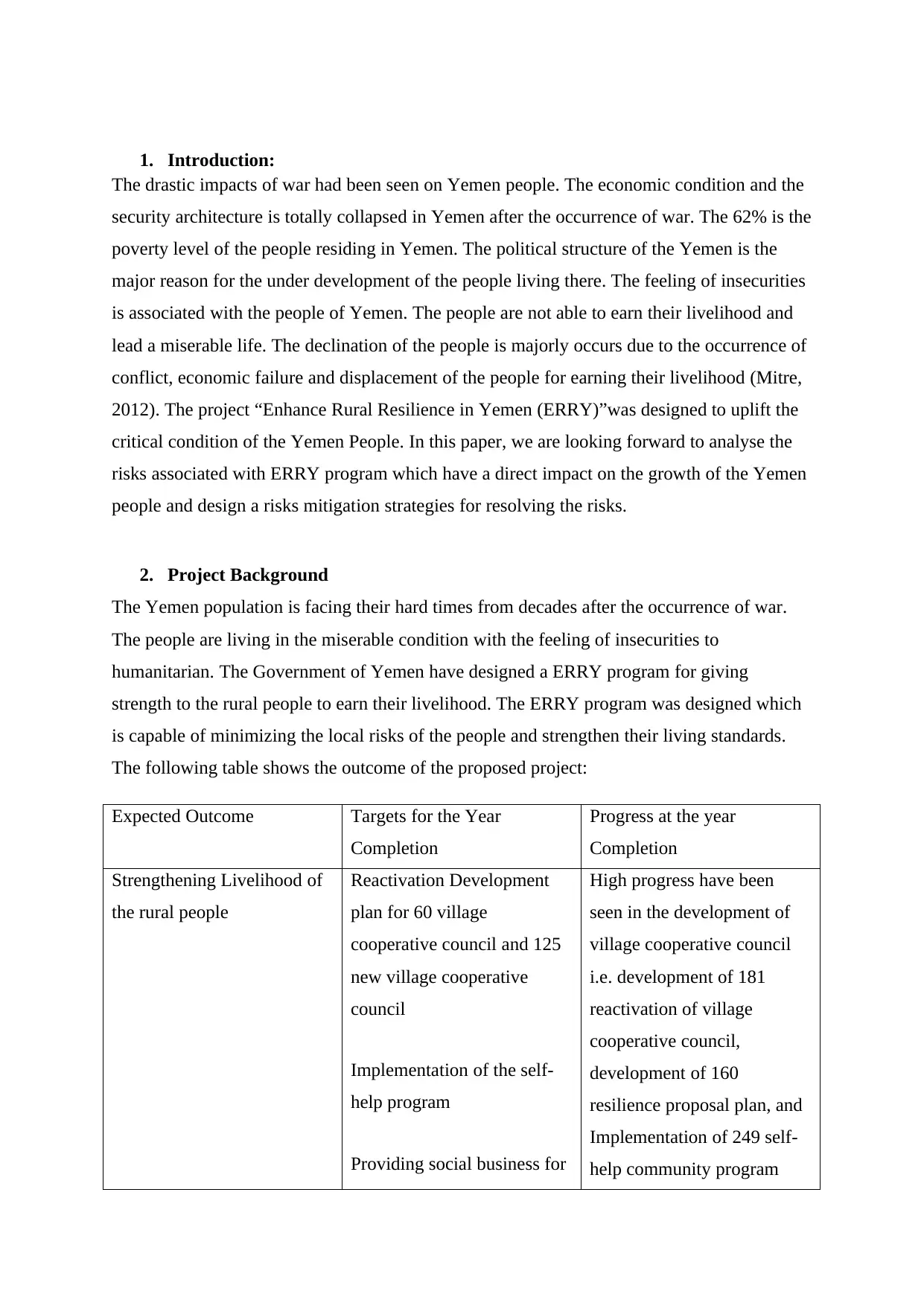
1. Introduction:
The drastic impacts of war had been seen on Yemen people. The economic condition and the
security architecture is totally collapsed in Yemen after the occurrence of war. The 62% is the
poverty level of the people residing in Yemen. The political structure of the Yemen is the
major reason for the under development of the people living there. The feeling of insecurities
is associated with the people of Yemen. The people are not able to earn their livelihood and
lead a miserable life. The declination of the people is majorly occurs due to the occurrence of
conflict, economic failure and displacement of the people for earning their livelihood (Mitre,
2012). The project “Enhance Rural Resilience in Yemen (ERRY)”was designed to uplift the
critical condition of the Yemen People. In this paper, we are looking forward to analyse the
risks associated with ERRY program which have a direct impact on the growth of the Yemen
people and design a risks mitigation strategies for resolving the risks.
2. Project Background
The Yemen population is facing their hard times from decades after the occurrence of war.
The people are living in the miserable condition with the feeling of insecurities to
humanitarian. The Government of Yemen have designed a ERRY program for giving
strength to the rural people to earn their livelihood. The ERRY program was designed which
is capable of minimizing the local risks of the people and strengthen their living standards.
The following table shows the outcome of the proposed project:
Expected Outcome Targets for the Year
Completion
Progress at the year
Completion
Strengthening Livelihood of
the rural people
Reactivation Development
plan for 60 village
cooperative council and 125
new village cooperative
council
Implementation of the self-
help program
Providing social business for
High progress have been
seen in the development of
village cooperative council
i.e. development of 181
reactivation of village
cooperative council,
development of 160
resilience proposal plan, and
Implementation of 249 self-
help community program
The drastic impacts of war had been seen on Yemen people. The economic condition and the
security architecture is totally collapsed in Yemen after the occurrence of war. The 62% is the
poverty level of the people residing in Yemen. The political structure of the Yemen is the
major reason for the under development of the people living there. The feeling of insecurities
is associated with the people of Yemen. The people are not able to earn their livelihood and
lead a miserable life. The declination of the people is majorly occurs due to the occurrence of
conflict, economic failure and displacement of the people for earning their livelihood (Mitre,
2012). The project “Enhance Rural Resilience in Yemen (ERRY)”was designed to uplift the
critical condition of the Yemen People. In this paper, we are looking forward to analyse the
risks associated with ERRY program which have a direct impact on the growth of the Yemen
people and design a risks mitigation strategies for resolving the risks.
2. Project Background
The Yemen population is facing their hard times from decades after the occurrence of war.
The people are living in the miserable condition with the feeling of insecurities to
humanitarian. The Government of Yemen have designed a ERRY program for giving
strength to the rural people to earn their livelihood. The ERRY program was designed which
is capable of minimizing the local risks of the people and strengthen their living standards.
The following table shows the outcome of the proposed project:
Expected Outcome Targets for the Year
Completion
Progress at the year
Completion
Strengthening Livelihood of
the rural people
Reactivation Development
plan for 60 village
cooperative council and 125
new village cooperative
council
Implementation of the self-
help program
Providing social business for
High progress have been
seen in the development of
village cooperative council
i.e. development of 181
reactivation of village
cooperative council,
development of 160
resilience proposal plan, and
Implementation of 249 self-
help community program
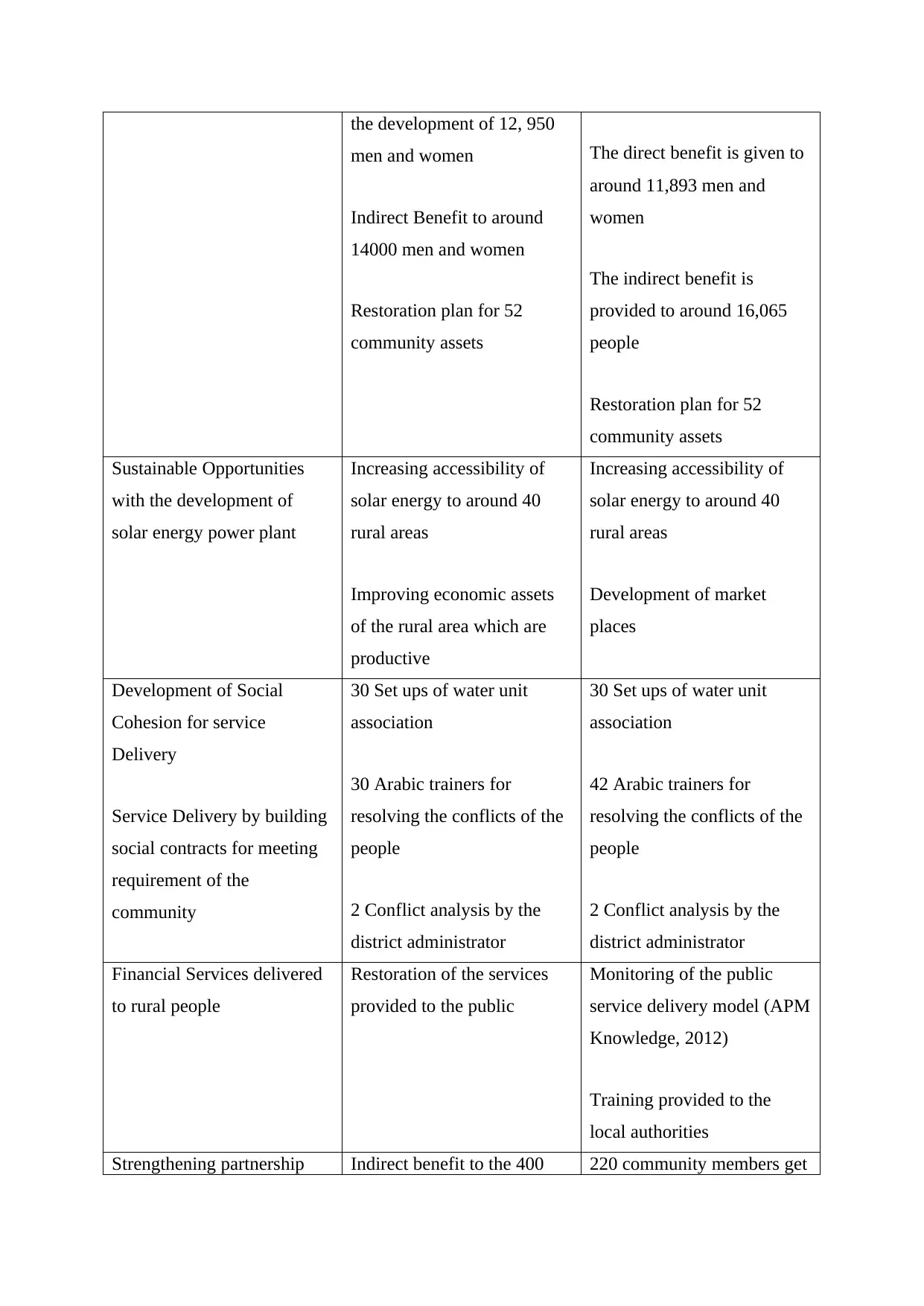
the development of 12, 950
men and women
Indirect Benefit to around
14000 men and women
Restoration plan for 52
community assets
The direct benefit is given to
around 11,893 men and
women
The indirect benefit is
provided to around 16,065
people
Restoration plan for 52
community assets
Sustainable Opportunities
with the development of
solar energy power plant
Increasing accessibility of
solar energy to around 40
rural areas
Improving economic assets
of the rural area which are
productive
Increasing accessibility of
solar energy to around 40
rural areas
Development of market
places
Development of Social
Cohesion for service
Delivery
Service Delivery by building
social contracts for meeting
requirement of the
community
30 Set ups of water unit
association
30 Arabic trainers for
resolving the conflicts of the
people
2 Conflict analysis by the
district administrator
30 Set ups of water unit
association
42 Arabic trainers for
resolving the conflicts of the
people
2 Conflict analysis by the
district administrator
Financial Services delivered
to rural people
Restoration of the services
provided to the public
Monitoring of the public
service delivery model (APM
Knowledge, 2012)
Training provided to the
local authorities
Strengthening partnership Indirect benefit to the 400 220 community members get
men and women
Indirect Benefit to around
14000 men and women
Restoration plan for 52
community assets
The direct benefit is given to
around 11,893 men and
women
The indirect benefit is
provided to around 16,065
people
Restoration plan for 52
community assets
Sustainable Opportunities
with the development of
solar energy power plant
Increasing accessibility of
solar energy to around 40
rural areas
Improving economic assets
of the rural area which are
productive
Increasing accessibility of
solar energy to around 40
rural areas
Development of market
places
Development of Social
Cohesion for service
Delivery
Service Delivery by building
social contracts for meeting
requirement of the
community
30 Set ups of water unit
association
30 Arabic trainers for
resolving the conflicts of the
people
2 Conflict analysis by the
district administrator
30 Set ups of water unit
association
42 Arabic trainers for
resolving the conflicts of the
people
2 Conflict analysis by the
district administrator
Financial Services delivered
to rural people
Restoration of the services
provided to the public
Monitoring of the public
service delivery model (APM
Knowledge, 2012)
Training provided to the
local authorities
Strengthening partnership Indirect benefit to the 400 220 community members get
Secure Best Marks with AI Grader
Need help grading? Try our AI Grader for instant feedback on your assignments.
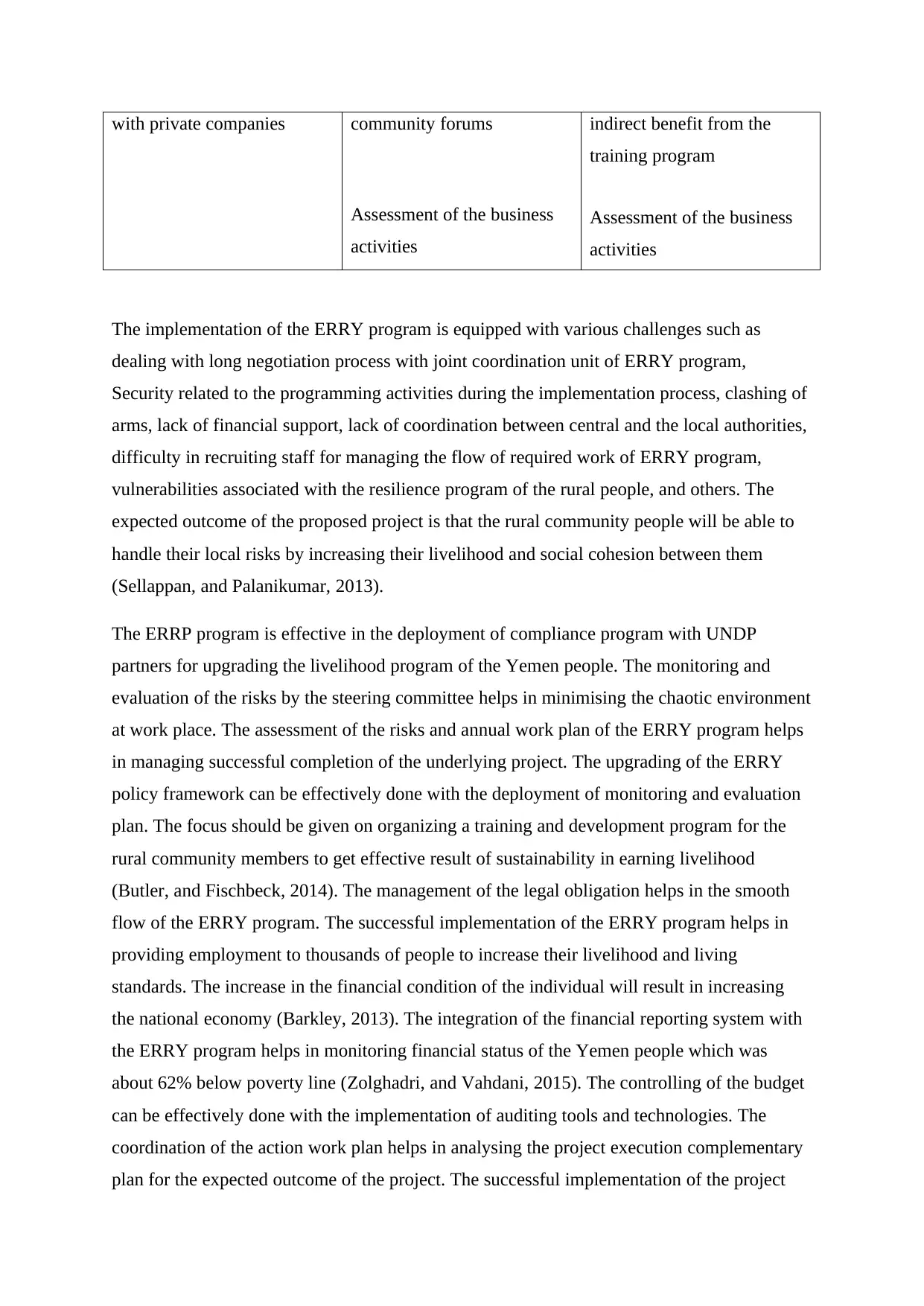
with private companies community forums
Assessment of the business
activities
indirect benefit from the
training program
Assessment of the business
activities
The implementation of the ERRY program is equipped with various challenges such as
dealing with long negotiation process with joint coordination unit of ERRY program,
Security related to the programming activities during the implementation process, clashing of
arms, lack of financial support, lack of coordination between central and the local authorities,
difficulty in recruiting staff for managing the flow of required work of ERRY program,
vulnerabilities associated with the resilience program of the rural people, and others. The
expected outcome of the proposed project is that the rural community people will be able to
handle their local risks by increasing their livelihood and social cohesion between them
(Sellappan, and Palanikumar, 2013).
The ERRP program is effective in the deployment of compliance program with UNDP
partners for upgrading the livelihood program of the Yemen people. The monitoring and
evaluation of the risks by the steering committee helps in minimising the chaotic environment
at work place. The assessment of the risks and annual work plan of the ERRY program helps
in managing successful completion of the underlying project. The upgrading of the ERRY
policy framework can be effectively done with the deployment of monitoring and evaluation
plan. The focus should be given on organizing a training and development program for the
rural community members to get effective result of sustainability in earning livelihood
(Butler, and Fischbeck, 2014). The management of the legal obligation helps in the smooth
flow of the ERRY program. The successful implementation of the ERRY program helps in
providing employment to thousands of people to increase their livelihood and living
standards. The increase in the financial condition of the individual will result in increasing
the national economy (Barkley, 2013). The integration of the financial reporting system with
the ERRY program helps in monitoring financial status of the Yemen people which was
about 62% below poverty line (Zolghadri, and Vahdani, 2015). The controlling of the budget
can be effectively done with the implementation of auditing tools and technologies. The
coordination of the action work plan helps in analysing the project execution complementary
plan for the expected outcome of the project. The successful implementation of the project
Assessment of the business
activities
indirect benefit from the
training program
Assessment of the business
activities
The implementation of the ERRY program is equipped with various challenges such as
dealing with long negotiation process with joint coordination unit of ERRY program,
Security related to the programming activities during the implementation process, clashing of
arms, lack of financial support, lack of coordination between central and the local authorities,
difficulty in recruiting staff for managing the flow of required work of ERRY program,
vulnerabilities associated with the resilience program of the rural people, and others. The
expected outcome of the proposed project is that the rural community people will be able to
handle their local risks by increasing their livelihood and social cohesion between them
(Sellappan, and Palanikumar, 2013).
The ERRP program is effective in the deployment of compliance program with UNDP
partners for upgrading the livelihood program of the Yemen people. The monitoring and
evaluation of the risks by the steering committee helps in minimising the chaotic environment
at work place. The assessment of the risks and annual work plan of the ERRY program helps
in managing successful completion of the underlying project. The upgrading of the ERRY
policy framework can be effectively done with the deployment of monitoring and evaluation
plan. The focus should be given on organizing a training and development program for the
rural community members to get effective result of sustainability in earning livelihood
(Butler, and Fischbeck, 2014). The management of the legal obligation helps in the smooth
flow of the ERRY program. The successful implementation of the ERRY program helps in
providing employment to thousands of people to increase their livelihood and living
standards. The increase in the financial condition of the individual will result in increasing
the national economy (Barkley, 2013). The integration of the financial reporting system with
the ERRY program helps in monitoring financial status of the Yemen people which was
about 62% below poverty line (Zolghadri, and Vahdani, 2015). The controlling of the budget
can be effectively done with the implementation of auditing tools and technologies. The
coordination of the action work plan helps in analysing the project execution complementary
plan for the expected outcome of the project. The successful implementation of the project
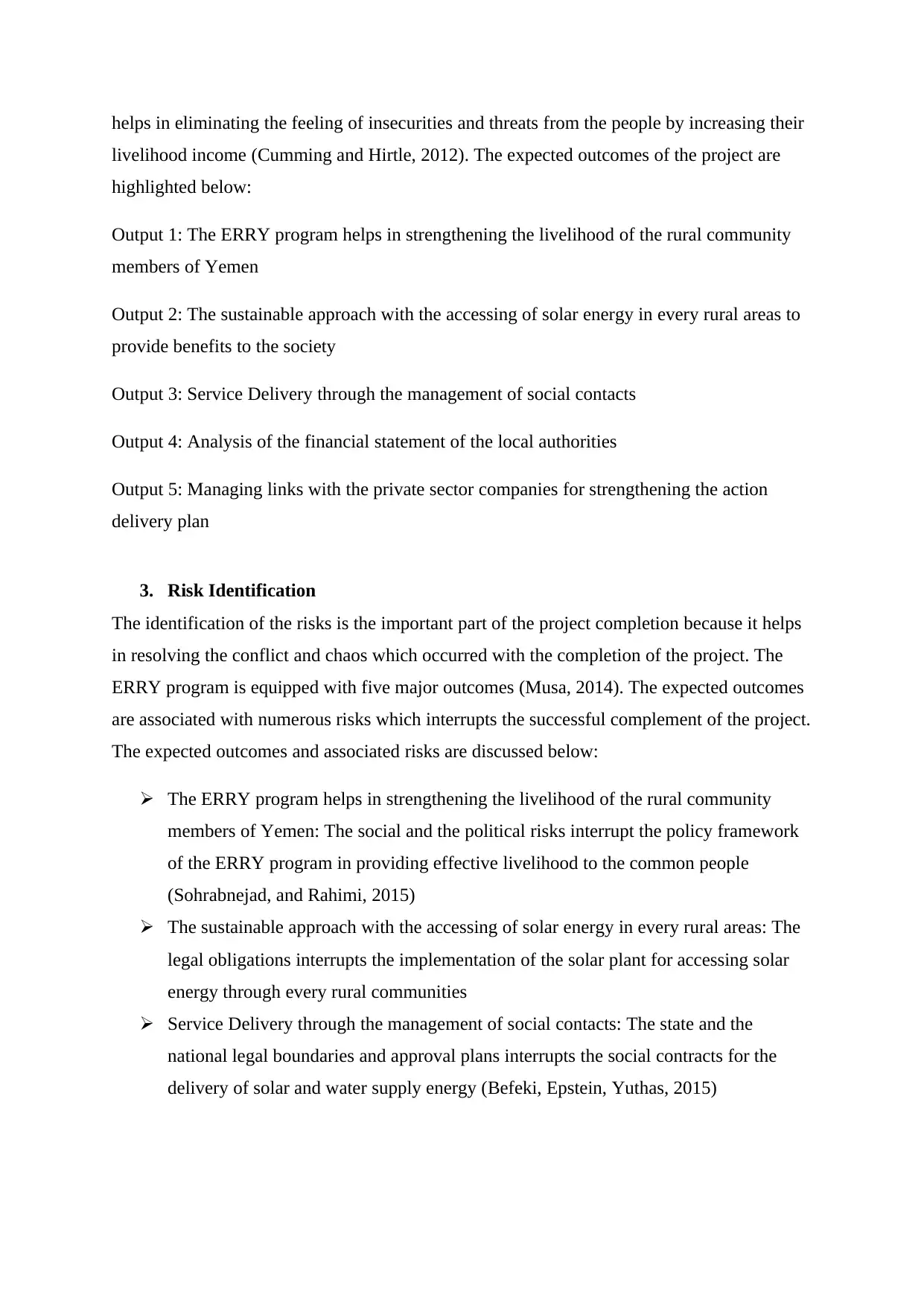
helps in eliminating the feeling of insecurities and threats from the people by increasing their
livelihood income (Cumming and Hirtle, 2012). The expected outcomes of the project are
highlighted below:
Output 1: The ERRY program helps in strengthening the livelihood of the rural community
members of Yemen
Output 2: The sustainable approach with the accessing of solar energy in every rural areas to
provide benefits to the society
Output 3: Service Delivery through the management of social contacts
Output 4: Analysis of the financial statement of the local authorities
Output 5: Managing links with the private sector companies for strengthening the action
delivery plan
3. Risk Identification
The identification of the risks is the important part of the project completion because it helps
in resolving the conflict and chaos which occurred with the completion of the project. The
ERRY program is equipped with five major outcomes (Musa, 2014). The expected outcomes
are associated with numerous risks which interrupts the successful complement of the project.
The expected outcomes and associated risks are discussed below:
The ERRY program helps in strengthening the livelihood of the rural community
members of Yemen: The social and the political risks interrupt the policy framework
of the ERRY program in providing effective livelihood to the common people
(Sohrabnejad, and Rahimi, 2015)
The sustainable approach with the accessing of solar energy in every rural areas: The
legal obligations interrupts the implementation of the solar plant for accessing solar
energy through every rural communities
Service Delivery through the management of social contacts: The state and the
national legal boundaries and approval plans interrupts the social contracts for the
delivery of solar and water supply energy (Befeki, Epstein, Yuthas, 2015)
livelihood income (Cumming and Hirtle, 2012). The expected outcomes of the project are
highlighted below:
Output 1: The ERRY program helps in strengthening the livelihood of the rural community
members of Yemen
Output 2: The sustainable approach with the accessing of solar energy in every rural areas to
provide benefits to the society
Output 3: Service Delivery through the management of social contacts
Output 4: Analysis of the financial statement of the local authorities
Output 5: Managing links with the private sector companies for strengthening the action
delivery plan
3. Risk Identification
The identification of the risks is the important part of the project completion because it helps
in resolving the conflict and chaos which occurred with the completion of the project. The
ERRY program is equipped with five major outcomes (Musa, 2014). The expected outcomes
are associated with numerous risks which interrupts the successful complement of the project.
The expected outcomes and associated risks are discussed below:
The ERRY program helps in strengthening the livelihood of the rural community
members of Yemen: The social and the political risks interrupt the policy framework
of the ERRY program in providing effective livelihood to the common people
(Sohrabnejad, and Rahimi, 2015)
The sustainable approach with the accessing of solar energy in every rural areas: The
legal obligations interrupts the implementation of the solar plant for accessing solar
energy through every rural communities
Service Delivery through the management of social contacts: The state and the
national legal boundaries and approval plans interrupts the social contracts for the
delivery of solar and water supply energy (Befeki, Epstein, Yuthas, 2015)
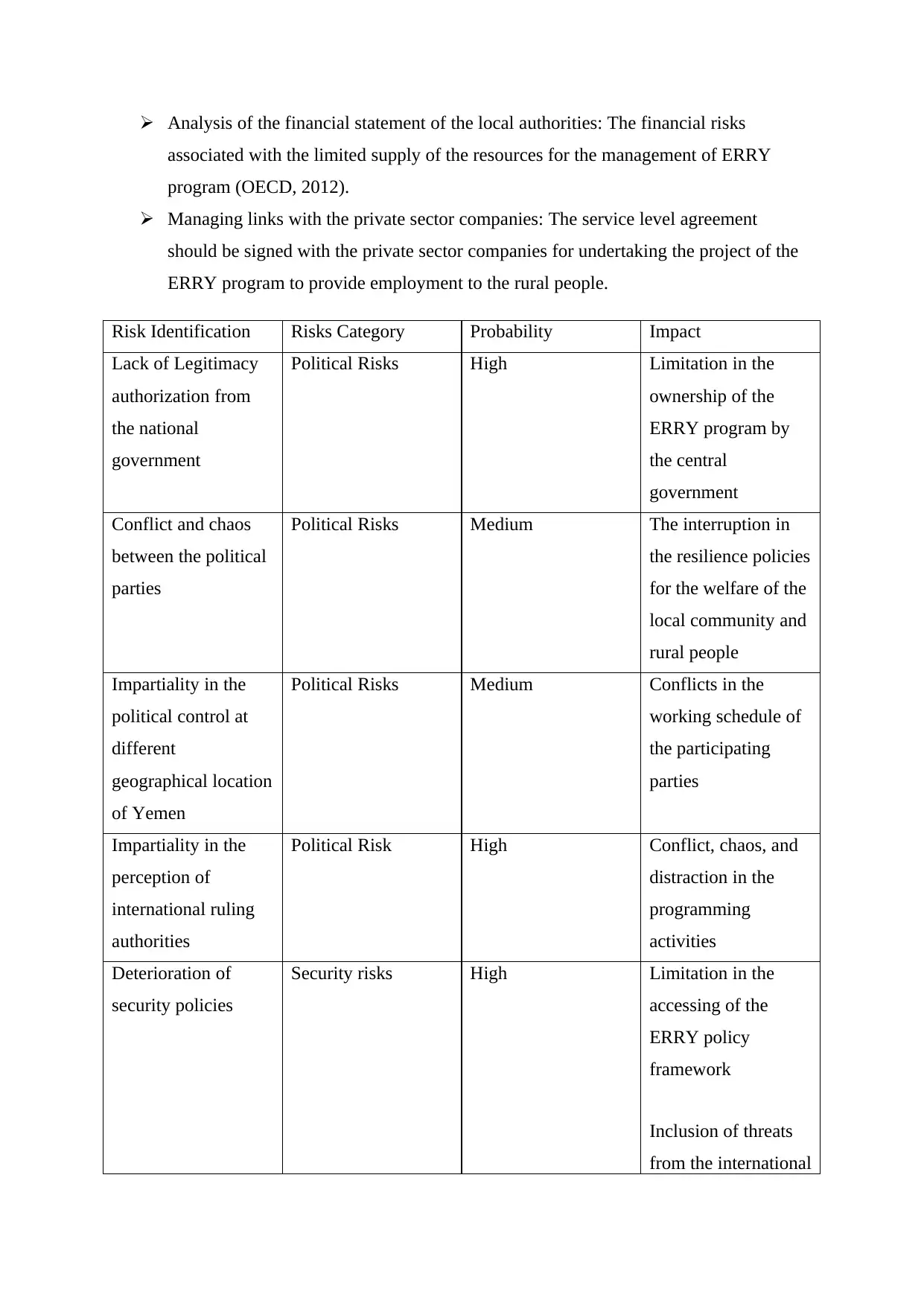
Analysis of the financial statement of the local authorities: The financial risks
associated with the limited supply of the resources for the management of ERRY
program (OECD, 2012).
Managing links with the private sector companies: The service level agreement
should be signed with the private sector companies for undertaking the project of the
ERRY program to provide employment to the rural people.
Risk Identification Risks Category Probability Impact
Lack of Legitimacy
authorization from
the national
government
Political Risks High Limitation in the
ownership of the
ERRY program by
the central
government
Conflict and chaos
between the political
parties
Political Risks Medium The interruption in
the resilience policies
for the welfare of the
local community and
rural people
Impartiality in the
political control at
different
geographical location
of Yemen
Political Risks Medium Conflicts in the
working schedule of
the participating
parties
Impartiality in the
perception of
international ruling
authorities
Political Risk High Conflict, chaos, and
distraction in the
programming
activities
Deterioration of
security policies
Security risks High Limitation in the
accessing of the
ERRY policy
framework
Inclusion of threats
from the international
associated with the limited supply of the resources for the management of ERRY
program (OECD, 2012).
Managing links with the private sector companies: The service level agreement
should be signed with the private sector companies for undertaking the project of the
ERRY program to provide employment to the rural people.
Risk Identification Risks Category Probability Impact
Lack of Legitimacy
authorization from
the national
government
Political Risks High Limitation in the
ownership of the
ERRY program by
the central
government
Conflict and chaos
between the political
parties
Political Risks Medium The interruption in
the resilience policies
for the welfare of the
local community and
rural people
Impartiality in the
political control at
different
geographical location
of Yemen
Political Risks Medium Conflicts in the
working schedule of
the participating
parties
Impartiality in the
perception of
international ruling
authorities
Political Risk High Conflict, chaos, and
distraction in the
programming
activities
Deterioration of
security policies
Security risks High Limitation in the
accessing of the
ERRY policy
framework
Inclusion of threats
from the international
Paraphrase This Document
Need a fresh take? Get an instant paraphrase of this document with our AI Paraphraser
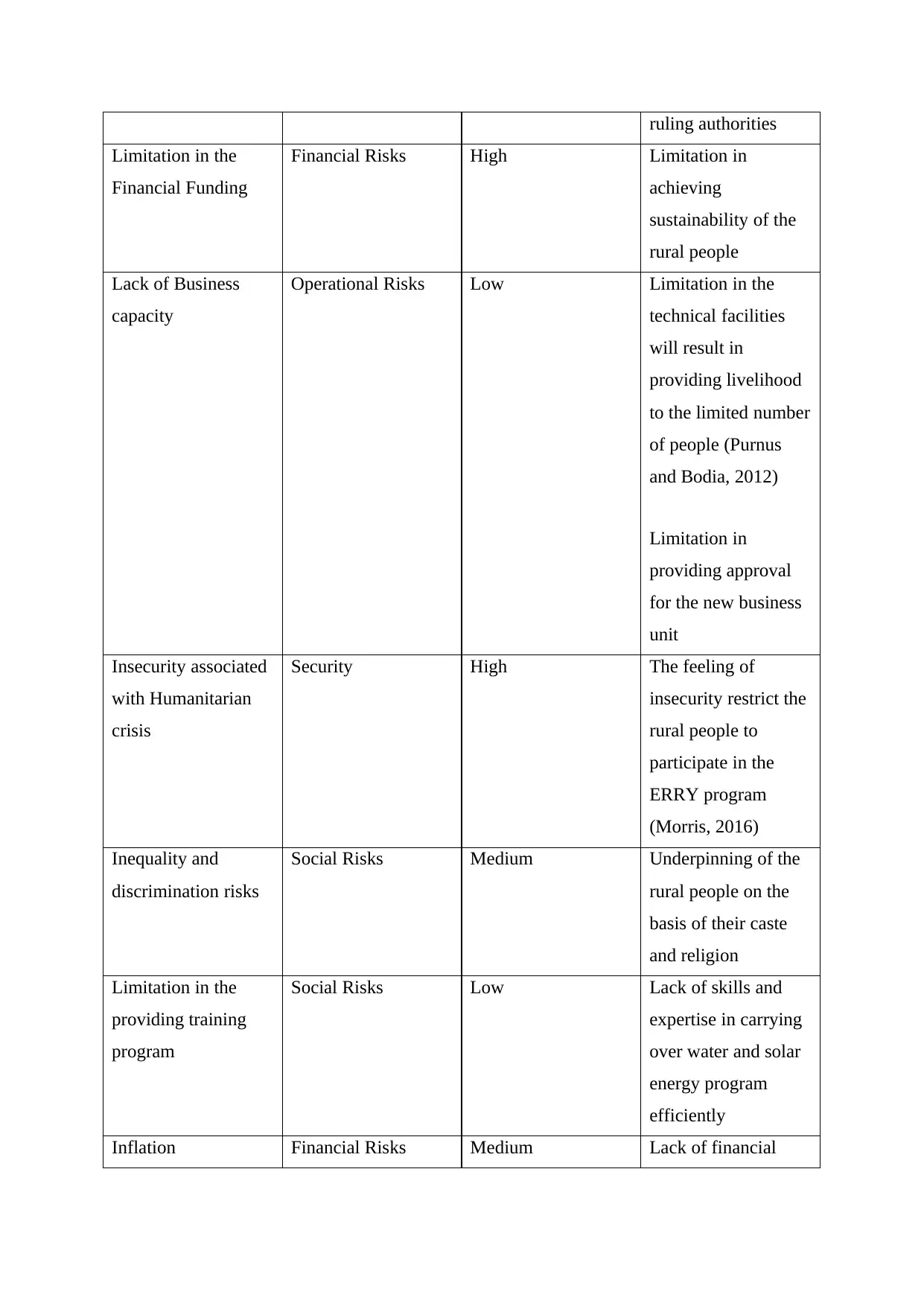
ruling authorities
Limitation in the
Financial Funding
Financial Risks High Limitation in
achieving
sustainability of the
rural people
Lack of Business
capacity
Operational Risks Low Limitation in the
technical facilities
will result in
providing livelihood
to the limited number
of people (Purnus
and Bodia, 2012)
Limitation in
providing approval
for the new business
unit
Insecurity associated
with Humanitarian
crisis
Security High The feeling of
insecurity restrict the
rural people to
participate in the
ERRY program
(Morris, 2016)
Inequality and
discrimination risks
Social Risks Medium Underpinning of the
rural people on the
basis of their caste
and religion
Limitation in the
providing training
program
Social Risks Low Lack of skills and
expertise in carrying
over water and solar
energy program
efficiently
Inflation Financial Risks Medium Lack of financial
Limitation in the
Financial Funding
Financial Risks High Limitation in
achieving
sustainability of the
rural people
Lack of Business
capacity
Operational Risks Low Limitation in the
technical facilities
will result in
providing livelihood
to the limited number
of people (Purnus
and Bodia, 2012)
Limitation in
providing approval
for the new business
unit
Insecurity associated
with Humanitarian
crisis
Security High The feeling of
insecurity restrict the
rural people to
participate in the
ERRY program
(Morris, 2016)
Inequality and
discrimination risks
Social Risks Medium Underpinning of the
rural people on the
basis of their caste
and religion
Limitation in the
providing training
program
Social Risks Low Lack of skills and
expertise in carrying
over water and solar
energy program
efficiently
Inflation Financial Risks Medium Lack of financial
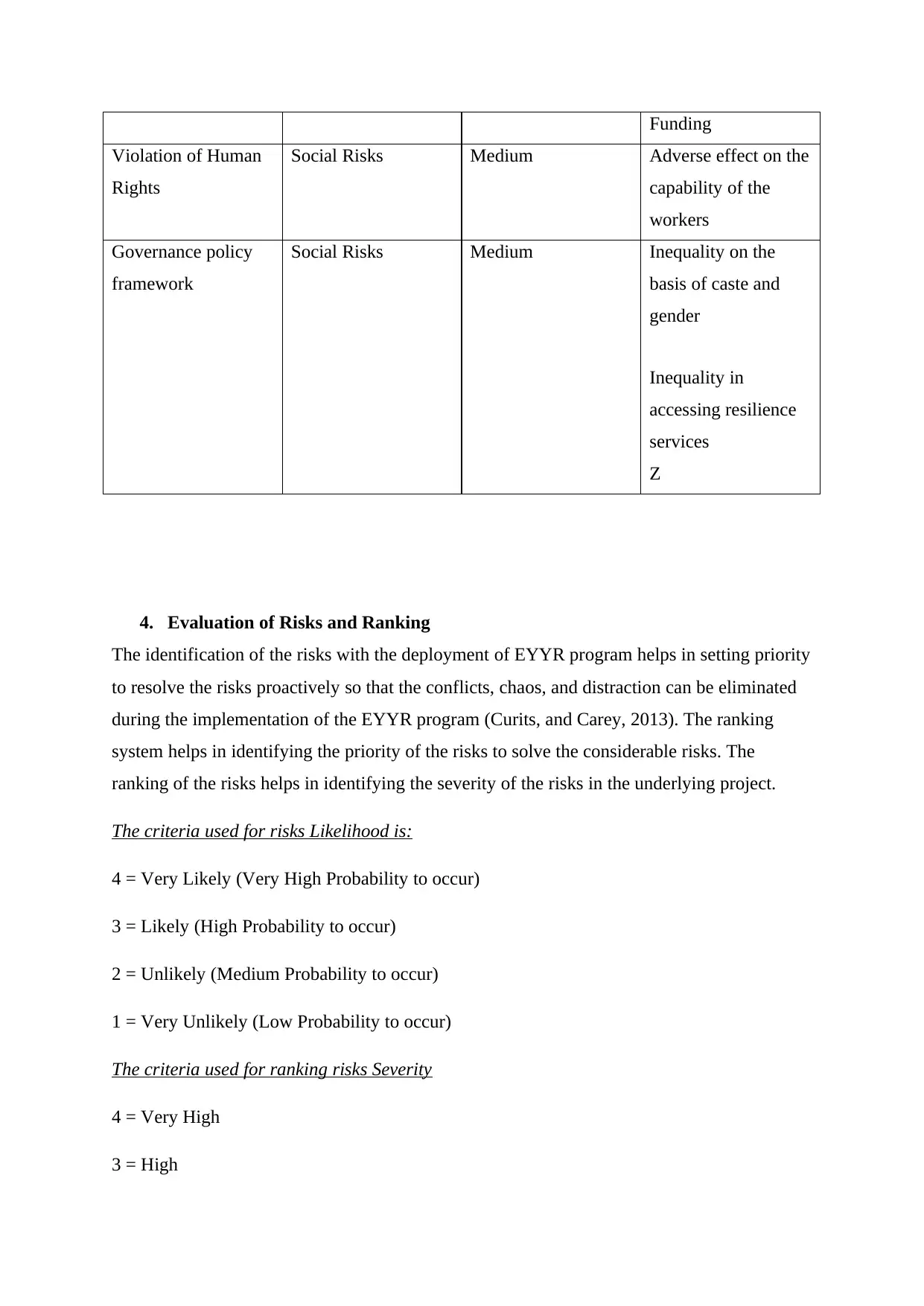
Funding
Violation of Human
Rights
Social Risks Medium Adverse effect on the
capability of the
workers
Governance policy
framework
Social Risks Medium Inequality on the
basis of caste and
gender
Inequality in
accessing resilience
services
Z
4. Evaluation of Risks and Ranking
The identification of the risks with the deployment of EYYR program helps in setting priority
to resolve the risks proactively so that the conflicts, chaos, and distraction can be eliminated
during the implementation of the EYYR program (Curits, and Carey, 2013). The ranking
system helps in identifying the priority of the risks to solve the considerable risks. The
ranking of the risks helps in identifying the severity of the risks in the underlying project.
The criteria used for risks Likelihood is:
4 = Very Likely (Very High Probability to occur)
3 = Likely (High Probability to occur)
2 = Unlikely (Medium Probability to occur)
1 = Very Unlikely (Low Probability to occur)
The criteria used for ranking risks Severity
4 = Very High
3 = High
Violation of Human
Rights
Social Risks Medium Adverse effect on the
capability of the
workers
Governance policy
framework
Social Risks Medium Inequality on the
basis of caste and
gender
Inequality in
accessing resilience
services
Z
4. Evaluation of Risks and Ranking
The identification of the risks with the deployment of EYYR program helps in setting priority
to resolve the risks proactively so that the conflicts, chaos, and distraction can be eliminated
during the implementation of the EYYR program (Curits, and Carey, 2013). The ranking
system helps in identifying the priority of the risks to solve the considerable risks. The
ranking of the risks helps in identifying the severity of the risks in the underlying project.
The criteria used for risks Likelihood is:
4 = Very Likely (Very High Probability to occur)
3 = Likely (High Probability to occur)
2 = Unlikely (Medium Probability to occur)
1 = Very Unlikely (Low Probability to occur)
The criteria used for ranking risks Severity
4 = Very High
3 = High
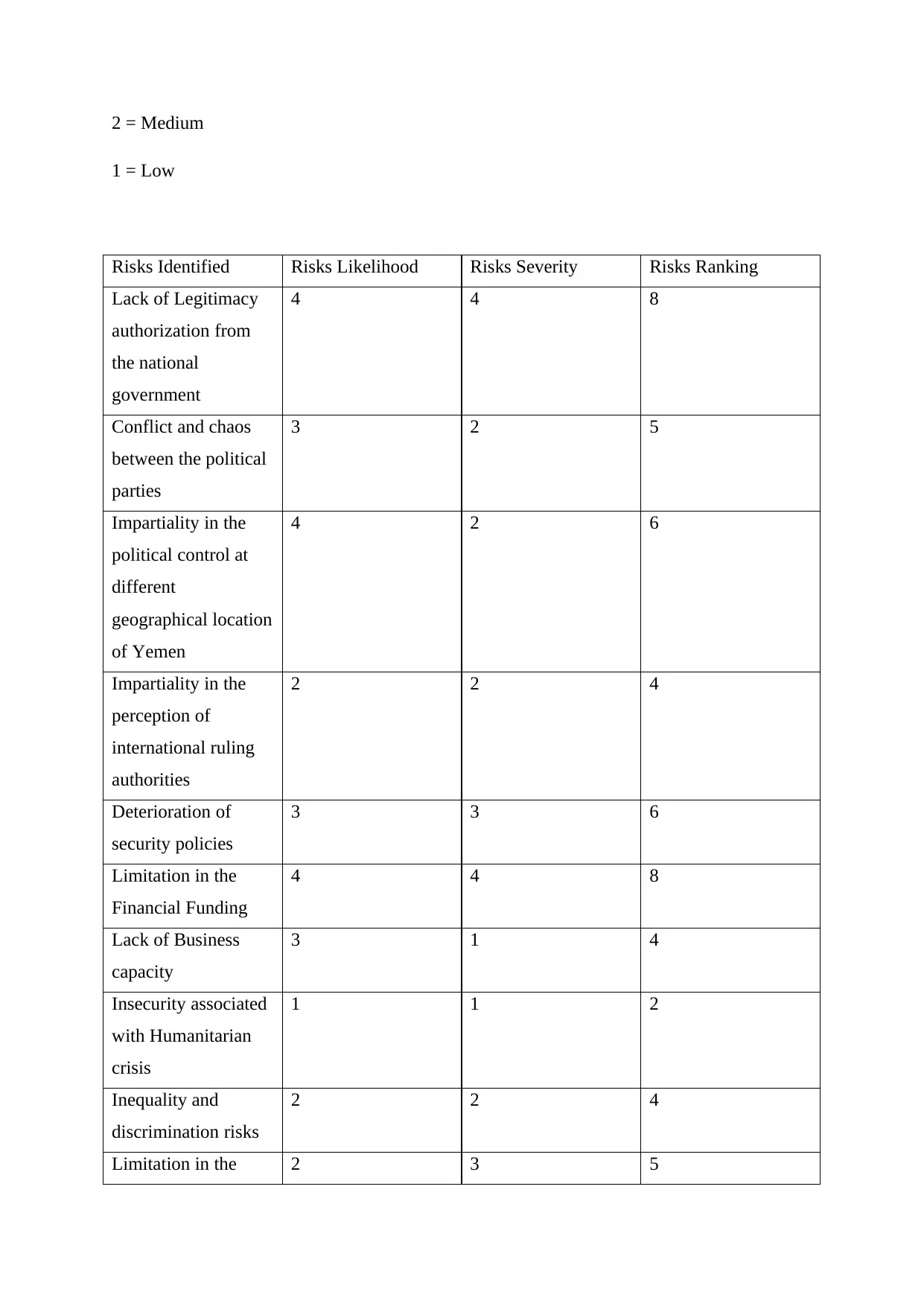
2 = Medium
1 = Low
Risks Identified Risks Likelihood Risks Severity Risks Ranking
Lack of Legitimacy
authorization from
the national
government
4 4 8
Conflict and chaos
between the political
parties
3 2 5
Impartiality in the
political control at
different
geographical location
of Yemen
4 2 6
Impartiality in the
perception of
international ruling
authorities
2 2 4
Deterioration of
security policies
3 3 6
Limitation in the
Financial Funding
4 4 8
Lack of Business
capacity
3 1 4
Insecurity associated
with Humanitarian
crisis
1 1 2
Inequality and
discrimination risks
2 2 4
Limitation in the 2 3 5
1 = Low
Risks Identified Risks Likelihood Risks Severity Risks Ranking
Lack of Legitimacy
authorization from
the national
government
4 4 8
Conflict and chaos
between the political
parties
3 2 5
Impartiality in the
political control at
different
geographical location
of Yemen
4 2 6
Impartiality in the
perception of
international ruling
authorities
2 2 4
Deterioration of
security policies
3 3 6
Limitation in the
Financial Funding
4 4 8
Lack of Business
capacity
3 1 4
Insecurity associated
with Humanitarian
crisis
1 1 2
Inequality and
discrimination risks
2 2 4
Limitation in the 2 3 5
Secure Best Marks with AI Grader
Need help grading? Try our AI Grader for instant feedback on your assignments.
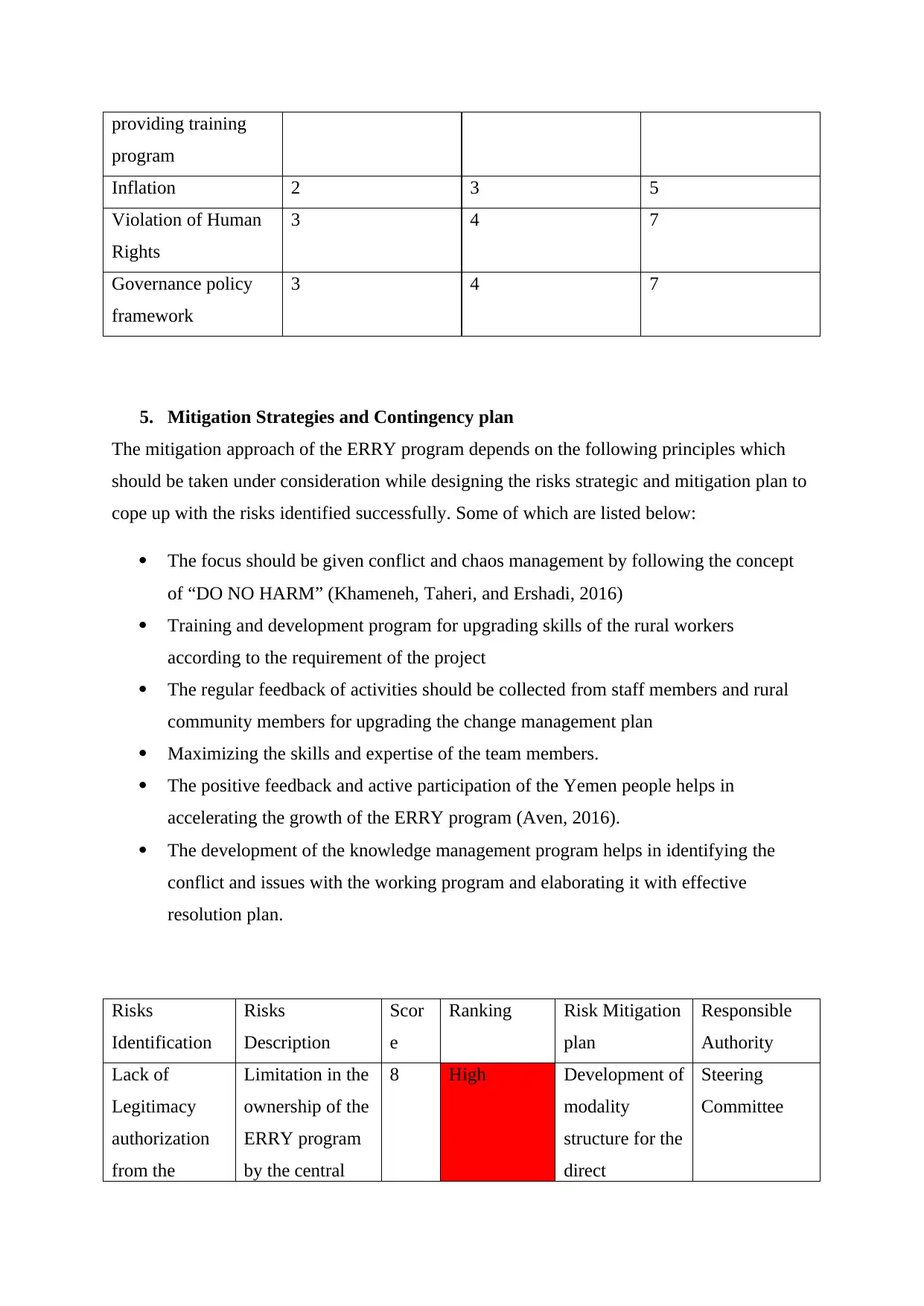
providing training
program
Inflation 2 3 5
Violation of Human
Rights
3 4 7
Governance policy
framework
3 4 7
5. Mitigation Strategies and Contingency plan
The mitigation approach of the ERRY program depends on the following principles which
should be taken under consideration while designing the risks strategic and mitigation plan to
cope up with the risks identified successfully. Some of which are listed below:
The focus should be given conflict and chaos management by following the concept
of “DO NO HARM” (Khameneh, Taheri, and Ershadi, 2016)
Training and development program for upgrading skills of the rural workers
according to the requirement of the project
The regular feedback of activities should be collected from staff members and rural
community members for upgrading the change management plan
Maximizing the skills and expertise of the team members.
The positive feedback and active participation of the Yemen people helps in
accelerating the growth of the ERRY program (Aven, 2016).
The development of the knowledge management program helps in identifying the
conflict and issues with the working program and elaborating it with effective
resolution plan.
Risks
Identification
Risks
Description
Scor
e
Ranking Risk Mitigation
plan
Responsible
Authority
Lack of
Legitimacy
authorization
from the
Limitation in the
ownership of the
ERRY program
by the central
8 High Development of
modality
structure for the
direct
Steering
Committee
program
Inflation 2 3 5
Violation of Human
Rights
3 4 7
Governance policy
framework
3 4 7
5. Mitigation Strategies and Contingency plan
The mitigation approach of the ERRY program depends on the following principles which
should be taken under consideration while designing the risks strategic and mitigation plan to
cope up with the risks identified successfully. Some of which are listed below:
The focus should be given conflict and chaos management by following the concept
of “DO NO HARM” (Khameneh, Taheri, and Ershadi, 2016)
Training and development program for upgrading skills of the rural workers
according to the requirement of the project
The regular feedback of activities should be collected from staff members and rural
community members for upgrading the change management plan
Maximizing the skills and expertise of the team members.
The positive feedback and active participation of the Yemen people helps in
accelerating the growth of the ERRY program (Aven, 2016).
The development of the knowledge management program helps in identifying the
conflict and issues with the working program and elaborating it with effective
resolution plan.
Risks
Identification
Risks
Description
Scor
e
Ranking Risk Mitigation
plan
Responsible
Authority
Lack of
Legitimacy
authorization
from the
Limitation in the
ownership of the
ERRY program
by the central
8 High Development of
modality
structure for the
direct
Steering
Committee
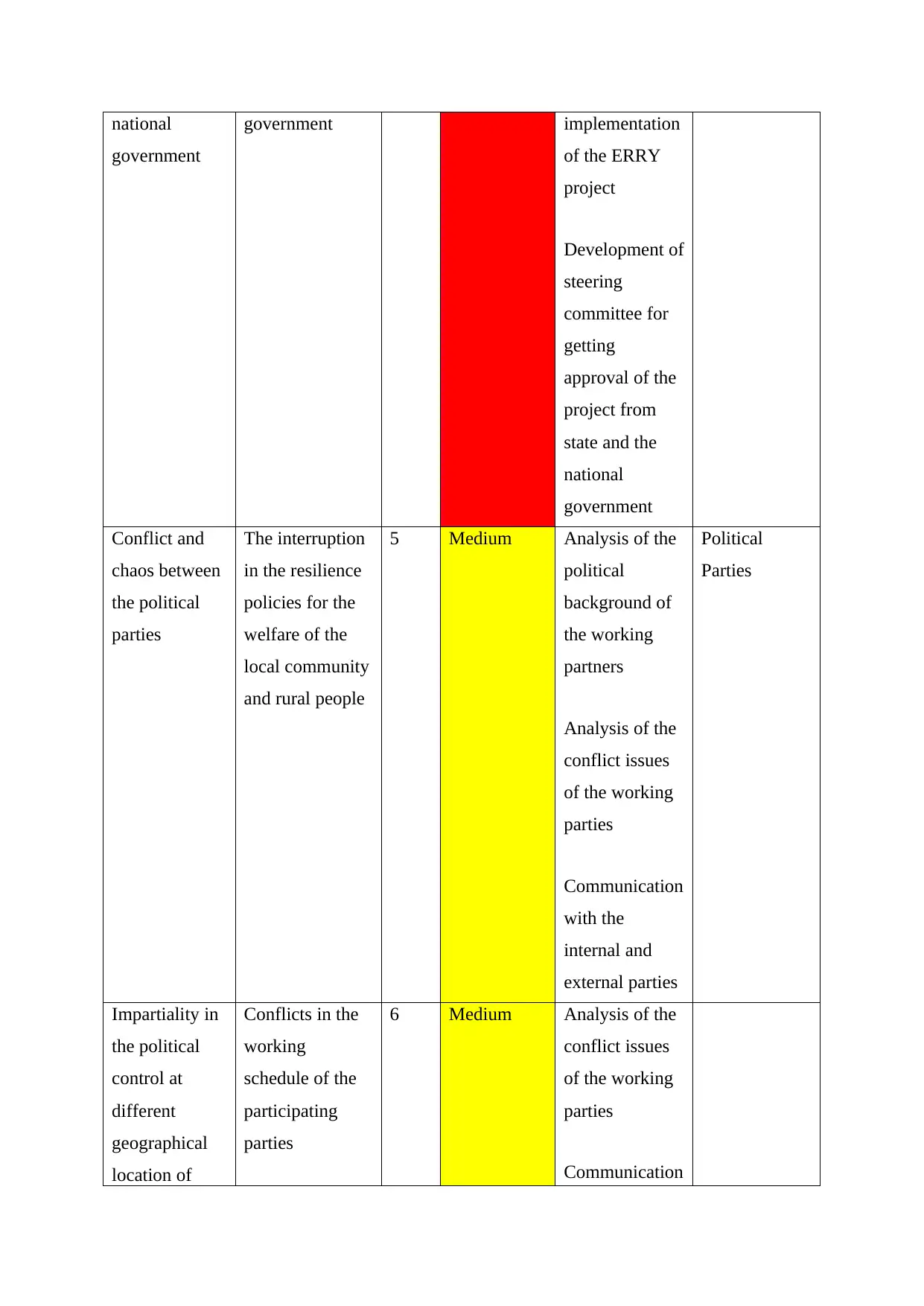
national
government
government implementation
of the ERRY
project
Development of
steering
committee for
getting
approval of the
project from
state and the
national
government
Conflict and
chaos between
the political
parties
The interruption
in the resilience
policies for the
welfare of the
local community
and rural people
5 Medium Analysis of the
political
background of
the working
partners
Analysis of the
conflict issues
of the working
parties
Communication
with the
internal and
external parties
Political
Parties
Impartiality in
the political
control at
different
geographical
location of
Conflicts in the
working
schedule of the
participating
parties
6 Medium Analysis of the
conflict issues
of the working
parties
Communication
government
government implementation
of the ERRY
project
Development of
steering
committee for
getting
approval of the
project from
state and the
national
government
Conflict and
chaos between
the political
parties
The interruption
in the resilience
policies for the
welfare of the
local community
and rural people
5 Medium Analysis of the
political
background of
the working
partners
Analysis of the
conflict issues
of the working
parties
Communication
with the
internal and
external parties
Political
Parties
Impartiality in
the political
control at
different
geographical
location of
Conflicts in the
working
schedule of the
participating
parties
6 Medium Analysis of the
conflict issues
of the working
parties
Communication
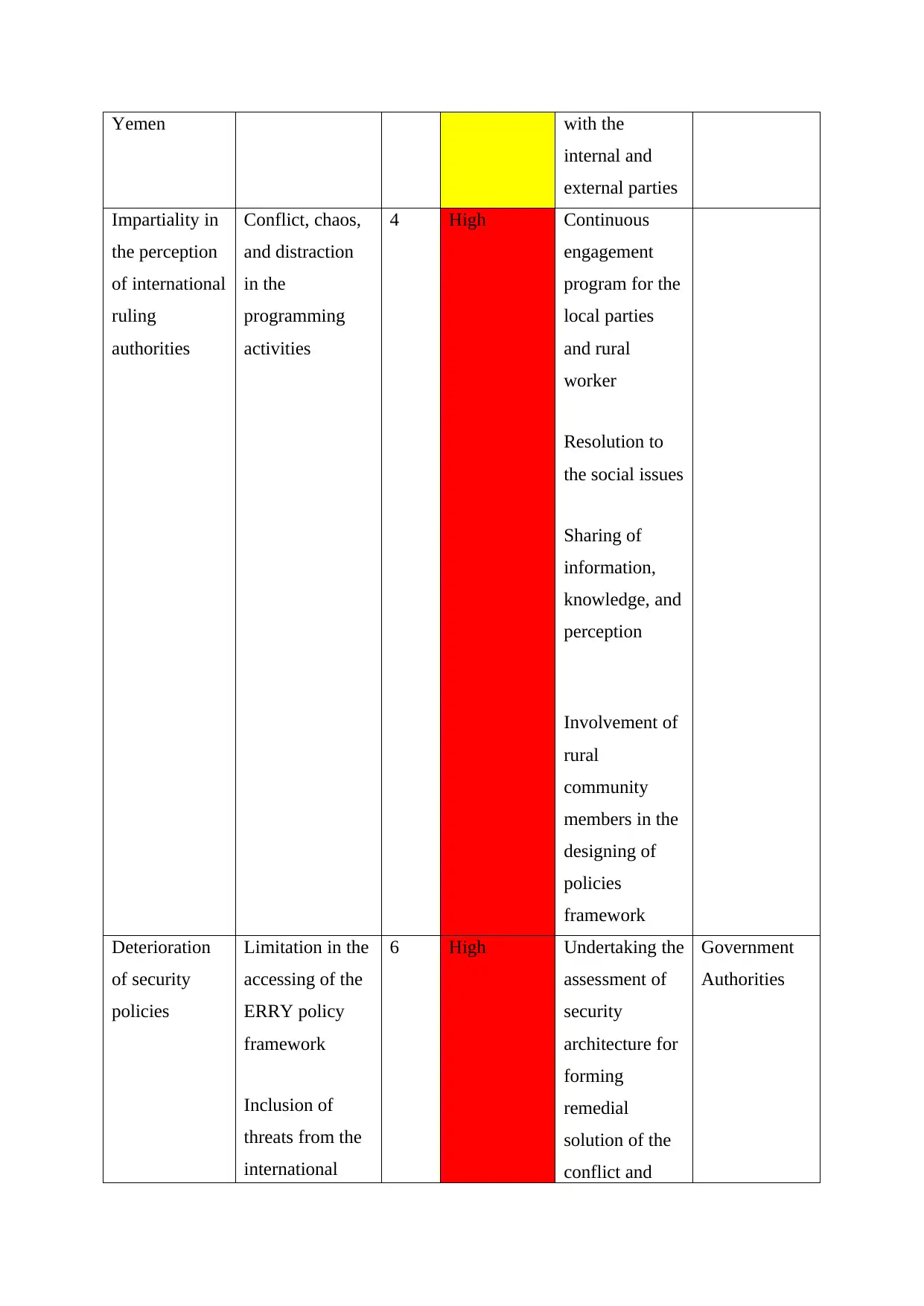
Yemen with the
internal and
external parties
Impartiality in
the perception
of international
ruling
authorities
Conflict, chaos,
and distraction
in the
programming
activities
4 High Continuous
engagement
program for the
local parties
and rural
worker
Resolution to
the social issues
Sharing of
information,
knowledge, and
perception
Involvement of
rural
community
members in the
designing of
policies
framework
Deterioration
of security
policies
Limitation in the
accessing of the
ERRY policy
framework
Inclusion of
threats from the
international
6 High Undertaking the
assessment of
security
architecture for
forming
remedial
solution of the
conflict and
Government
Authorities
internal and
external parties
Impartiality in
the perception
of international
ruling
authorities
Conflict, chaos,
and distraction
in the
programming
activities
4 High Continuous
engagement
program for the
local parties
and rural
worker
Resolution to
the social issues
Sharing of
information,
knowledge, and
perception
Involvement of
rural
community
members in the
designing of
policies
framework
Deterioration
of security
policies
Limitation in the
accessing of the
ERRY policy
framework
Inclusion of
threats from the
international
6 High Undertaking the
assessment of
security
architecture for
forming
remedial
solution of the
conflict and
Government
Authorities
Paraphrase This Document
Need a fresh take? Get an instant paraphrase of this document with our AI Paraphraser
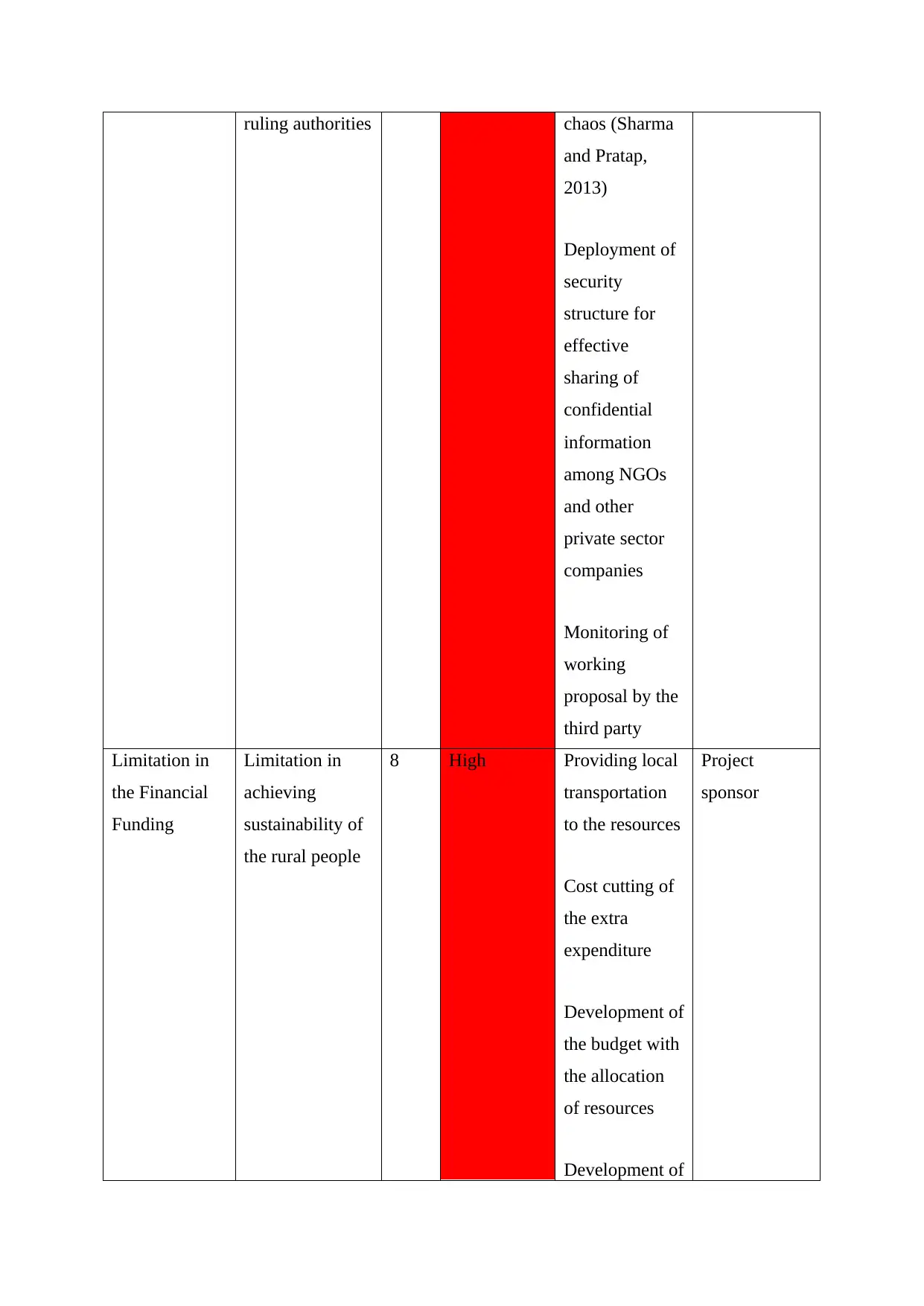
ruling authorities chaos (Sharma
and Pratap,
2013)
Deployment of
security
structure for
effective
sharing of
confidential
information
among NGOs
and other
private sector
companies
Monitoring of
working
proposal by the
third party
Limitation in
the Financial
Funding
Limitation in
achieving
sustainability of
the rural people
8 High Providing local
transportation
to the resources
Cost cutting of
the extra
expenditure
Development of
the budget with
the allocation
of resources
Development of
Project
sponsor
and Pratap,
2013)
Deployment of
security
structure for
effective
sharing of
confidential
information
among NGOs
and other
private sector
companies
Monitoring of
working
proposal by the
third party
Limitation in
the Financial
Funding
Limitation in
achieving
sustainability of
the rural people
8 High Providing local
transportation
to the resources
Cost cutting of
the extra
expenditure
Development of
the budget with
the allocation
of resources
Development of
Project
sponsor
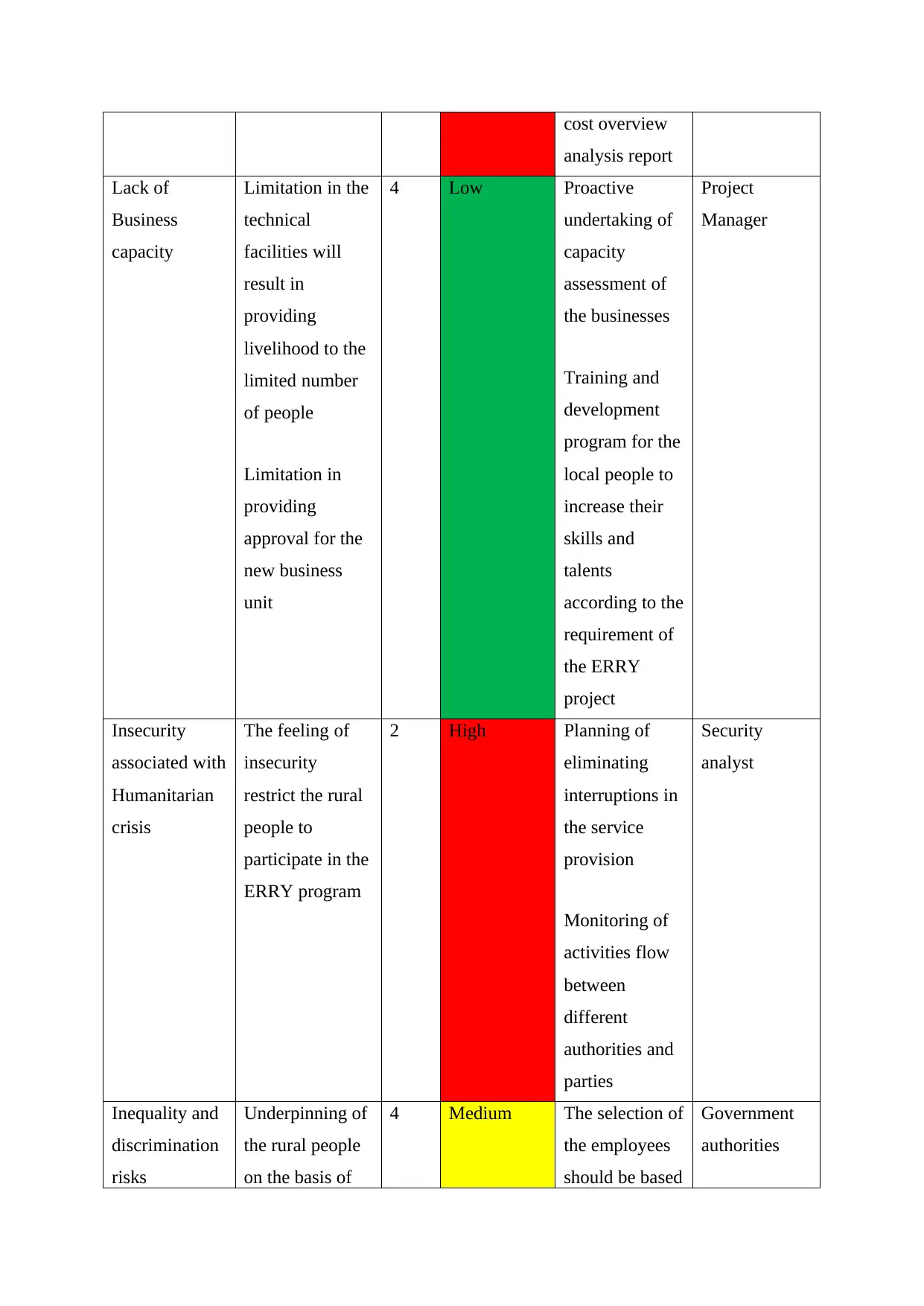
cost overview
analysis report
Lack of
Business
capacity
Limitation in the
technical
facilities will
result in
providing
livelihood to the
limited number
of people
Limitation in
providing
approval for the
new business
unit
4 Low Proactive
undertaking of
capacity
assessment of
the businesses
Training and
development
program for the
local people to
increase their
skills and
talents
according to the
requirement of
the ERRY
project
Project
Manager
Insecurity
associated with
Humanitarian
crisis
The feeling of
insecurity
restrict the rural
people to
participate in the
ERRY program
2 High Planning of
eliminating
interruptions in
the service
provision
Monitoring of
activities flow
between
different
authorities and
parties
Security
analyst
Inequality and
discrimination
risks
Underpinning of
the rural people
on the basis of
4 Medium The selection of
the employees
should be based
Government
authorities
analysis report
Lack of
Business
capacity
Limitation in the
technical
facilities will
result in
providing
livelihood to the
limited number
of people
Limitation in
providing
approval for the
new business
unit
4 Low Proactive
undertaking of
capacity
assessment of
the businesses
Training and
development
program for the
local people to
increase their
skills and
talents
according to the
requirement of
the ERRY
project
Project
Manager
Insecurity
associated with
Humanitarian
crisis
The feeling of
insecurity
restrict the rural
people to
participate in the
ERRY program
2 High Planning of
eliminating
interruptions in
the service
provision
Monitoring of
activities flow
between
different
authorities and
parties
Security
analyst
Inequality and
discrimination
risks
Underpinning of
the rural people
on the basis of
4 Medium The selection of
the employees
should be based
Government
authorities
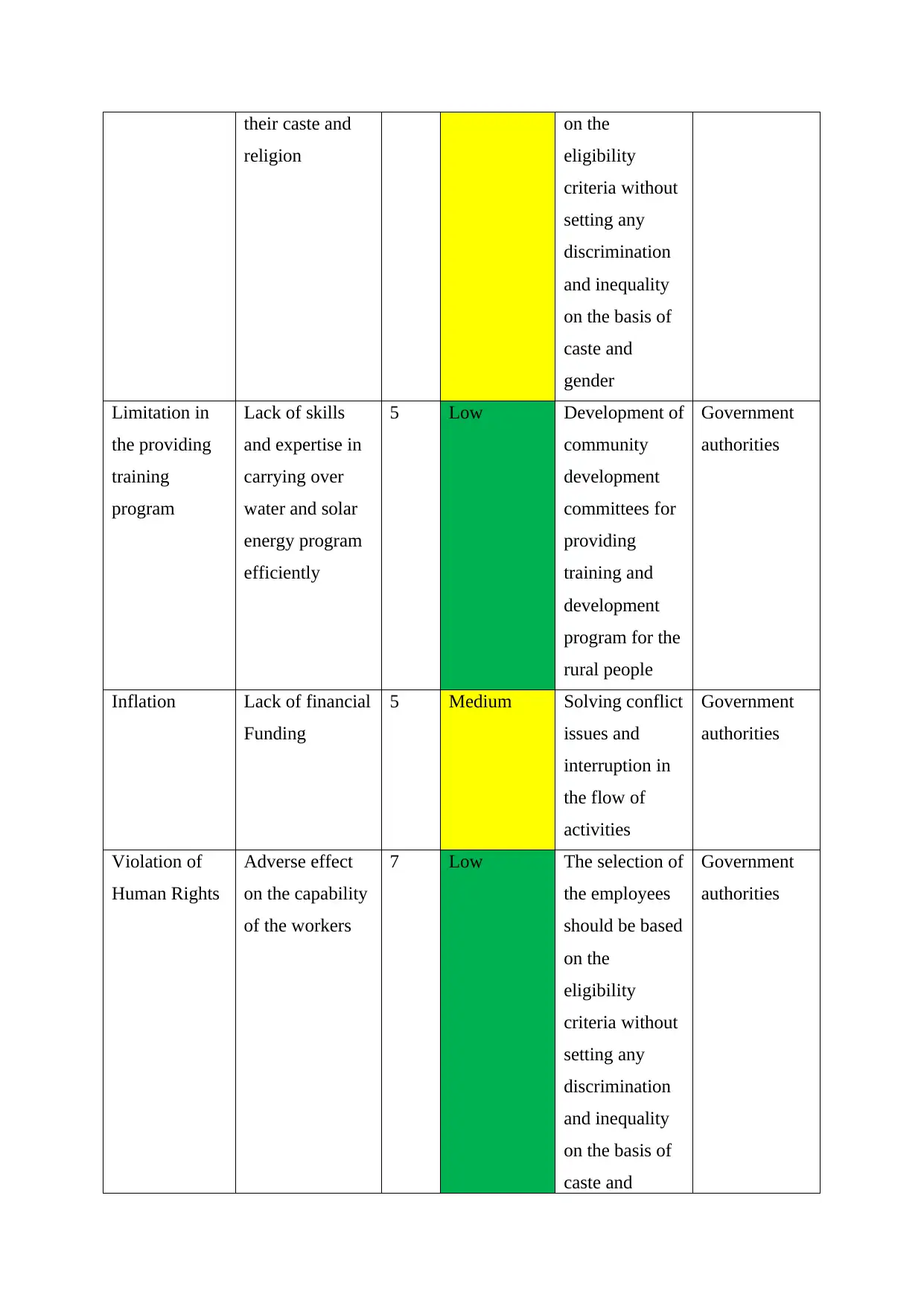
their caste and
religion
on the
eligibility
criteria without
setting any
discrimination
and inequality
on the basis of
caste and
gender
Limitation in
the providing
training
program
Lack of skills
and expertise in
carrying over
water and solar
energy program
efficiently
5 Low Development of
community
development
committees for
providing
training and
development
program for the
rural people
Government
authorities
Inflation Lack of financial
Funding
5 Medium Solving conflict
issues and
interruption in
the flow of
activities
Government
authorities
Violation of
Human Rights
Adverse effect
on the capability
of the workers
7 Low The selection of
the employees
should be based
on the
eligibility
criteria without
setting any
discrimination
and inequality
on the basis of
caste and
Government
authorities
religion
on the
eligibility
criteria without
setting any
discrimination
and inequality
on the basis of
caste and
gender
Limitation in
the providing
training
program
Lack of skills
and expertise in
carrying over
water and solar
energy program
efficiently
5 Low Development of
community
development
committees for
providing
training and
development
program for the
rural people
Government
authorities
Inflation Lack of financial
Funding
5 Medium Solving conflict
issues and
interruption in
the flow of
activities
Government
authorities
Violation of
Human Rights
Adverse effect
on the capability
of the workers
7 Low The selection of
the employees
should be based
on the
eligibility
criteria without
setting any
discrimination
and inequality
on the basis of
caste and
Government
authorities
Secure Best Marks with AI Grader
Need help grading? Try our AI Grader for instant feedback on your assignments.
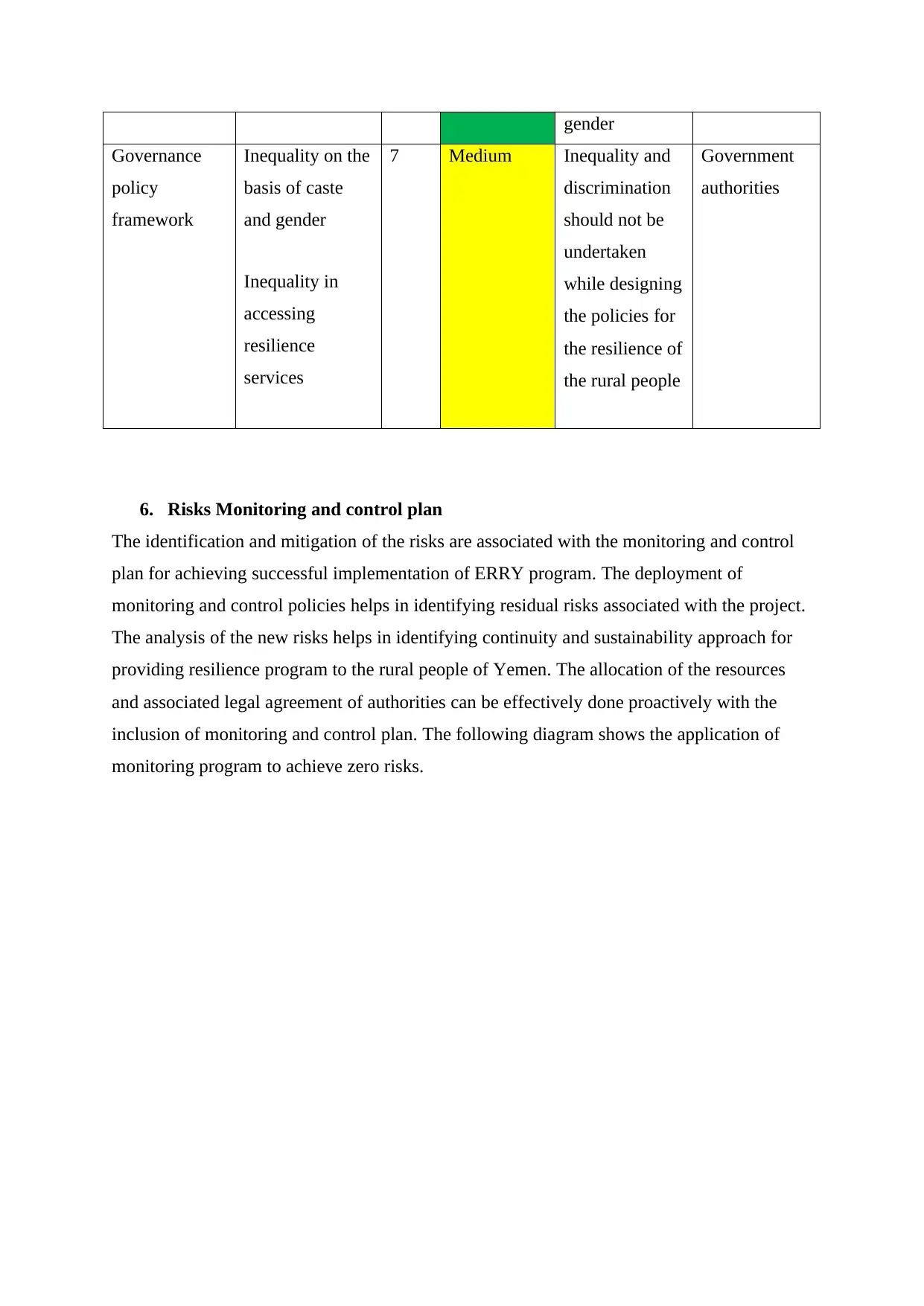
gender
Governance
policy
framework
Inequality on the
basis of caste
and gender
Inequality in
accessing
resilience
services
7 Medium Inequality and
discrimination
should not be
undertaken
while designing
the policies for
the resilience of
the rural people
Government
authorities
6. Risks Monitoring and control plan
The identification and mitigation of the risks are associated with the monitoring and control
plan for achieving successful implementation of ERRY program. The deployment of
monitoring and control policies helps in identifying residual risks associated with the project.
The analysis of the new risks helps in identifying continuity and sustainability approach for
providing resilience program to the rural people of Yemen. The allocation of the resources
and associated legal agreement of authorities can be effectively done proactively with the
inclusion of monitoring and control plan. The following diagram shows the application of
monitoring program to achieve zero risks.
Governance
policy
framework
Inequality on the
basis of caste
and gender
Inequality in
accessing
resilience
services
7 Medium Inequality and
discrimination
should not be
undertaken
while designing
the policies for
the resilience of
the rural people
Government
authorities
6. Risks Monitoring and control plan
The identification and mitigation of the risks are associated with the monitoring and control
plan for achieving successful implementation of ERRY program. The deployment of
monitoring and control policies helps in identifying residual risks associated with the project.
The analysis of the new risks helps in identifying continuity and sustainability approach for
providing resilience program to the rural people of Yemen. The allocation of the resources
and associated legal agreement of authorities can be effectively done proactively with the
inclusion of monitoring and control plan. The following diagram shows the application of
monitoring program to achieve zero risks.
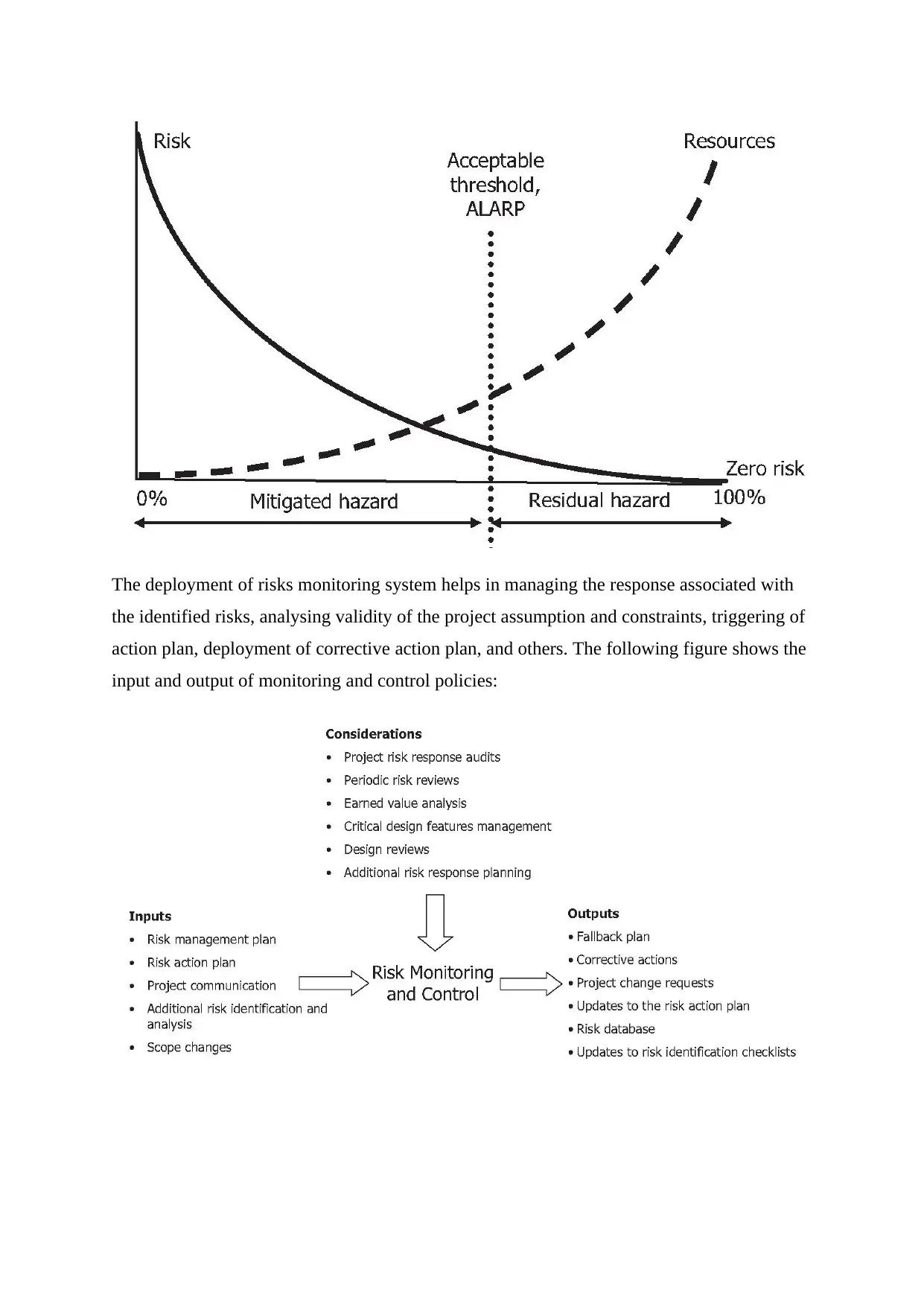
The deployment of risks monitoring system helps in managing the response associated with
the identified risks, analysing validity of the project assumption and constraints, triggering of
action plan, deployment of corrective action plan, and others. The following figure shows the
input and output of monitoring and control policies:
the identified risks, analysing validity of the project assumption and constraints, triggering of
action plan, deployment of corrective action plan, and others. The following figure shows the
input and output of monitoring and control policies:
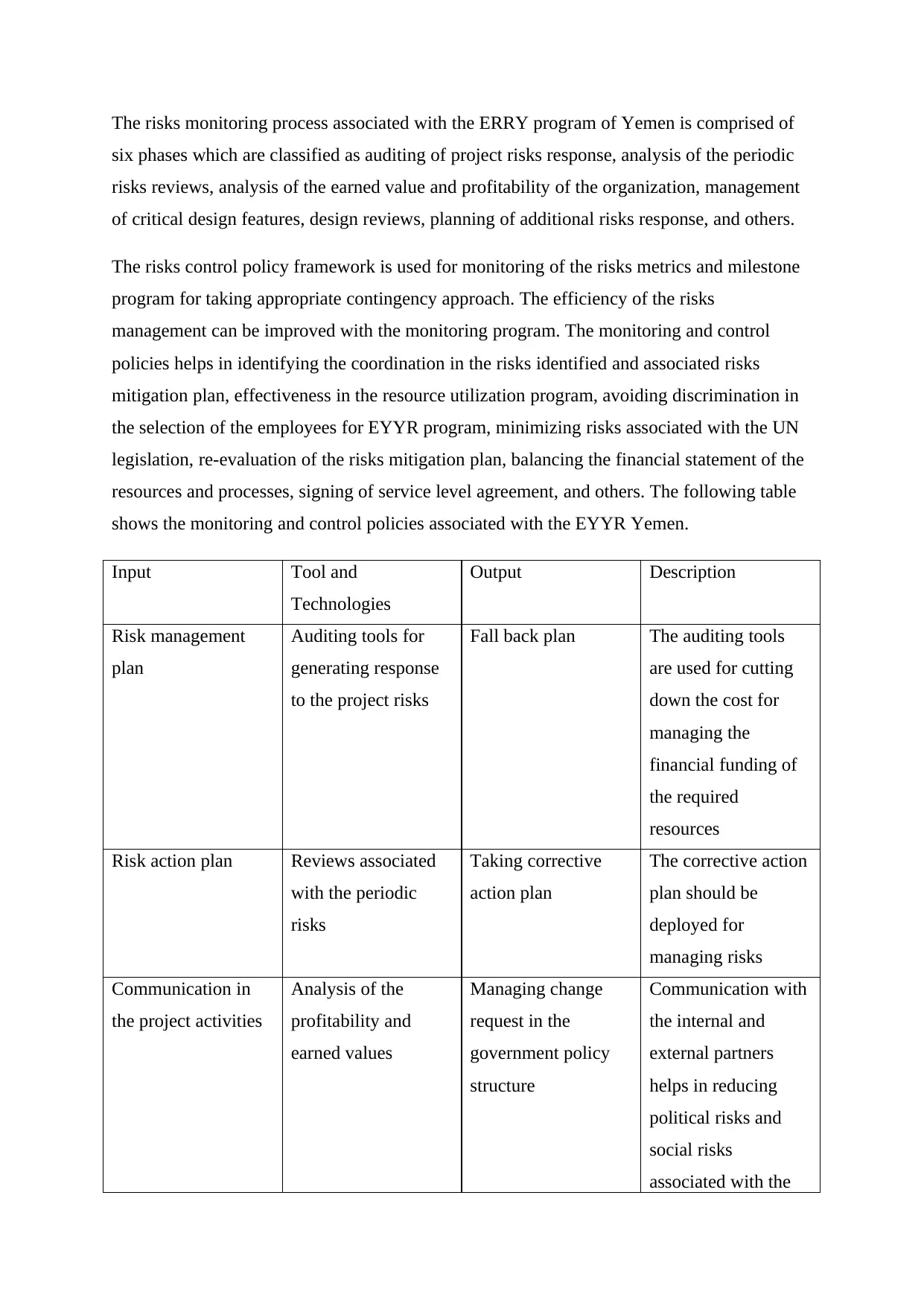
The risks monitoring process associated with the ERRY program of Yemen is comprised of
six phases which are classified as auditing of project risks response, analysis of the periodic
risks reviews, analysis of the earned value and profitability of the organization, management
of critical design features, design reviews, planning of additional risks response, and others.
The risks control policy framework is used for monitoring of the risks metrics and milestone
program for taking appropriate contingency approach. The efficiency of the risks
management can be improved with the monitoring program. The monitoring and control
policies helps in identifying the coordination in the risks identified and associated risks
mitigation plan, effectiveness in the resource utilization program, avoiding discrimination in
the selection of the employees for EYYR program, minimizing risks associated with the UN
legislation, re-evaluation of the risks mitigation plan, balancing the financial statement of the
resources and processes, signing of service level agreement, and others. The following table
shows the monitoring and control policies associated with the EYYR Yemen.
Input Tool and
Technologies
Output Description
Risk management
plan
Auditing tools for
generating response
to the project risks
Fall back plan The auditing tools
are used for cutting
down the cost for
managing the
financial funding of
the required
resources
Risk action plan Reviews associated
with the periodic
risks
Taking corrective
action plan
The corrective action
plan should be
deployed for
managing risks
Communication in
the project activities
Analysis of the
profitability and
earned values
Managing change
request in the
government policy
structure
Communication with
the internal and
external partners
helps in reducing
political risks and
social risks
associated with the
six phases which are classified as auditing of project risks response, analysis of the periodic
risks reviews, analysis of the earned value and profitability of the organization, management
of critical design features, design reviews, planning of additional risks response, and others.
The risks control policy framework is used for monitoring of the risks metrics and milestone
program for taking appropriate contingency approach. The efficiency of the risks
management can be improved with the monitoring program. The monitoring and control
policies helps in identifying the coordination in the risks identified and associated risks
mitigation plan, effectiveness in the resource utilization program, avoiding discrimination in
the selection of the employees for EYYR program, minimizing risks associated with the UN
legislation, re-evaluation of the risks mitigation plan, balancing the financial statement of the
resources and processes, signing of service level agreement, and others. The following table
shows the monitoring and control policies associated with the EYYR Yemen.
Input Tool and
Technologies
Output Description
Risk management
plan
Auditing tools for
generating response
to the project risks
Fall back plan The auditing tools
are used for cutting
down the cost for
managing the
financial funding of
the required
resources
Risk action plan Reviews associated
with the periodic
risks
Taking corrective
action plan
The corrective action
plan should be
deployed for
managing risks
Communication in
the project activities
Analysis of the
profitability and
earned values
Managing change
request in the
government policy
structure
Communication with
the internal and
external partners
helps in reducing
political risks and
social risks
associated with the
Paraphrase This Document
Need a fresh take? Get an instant paraphrase of this document with our AI Paraphraser
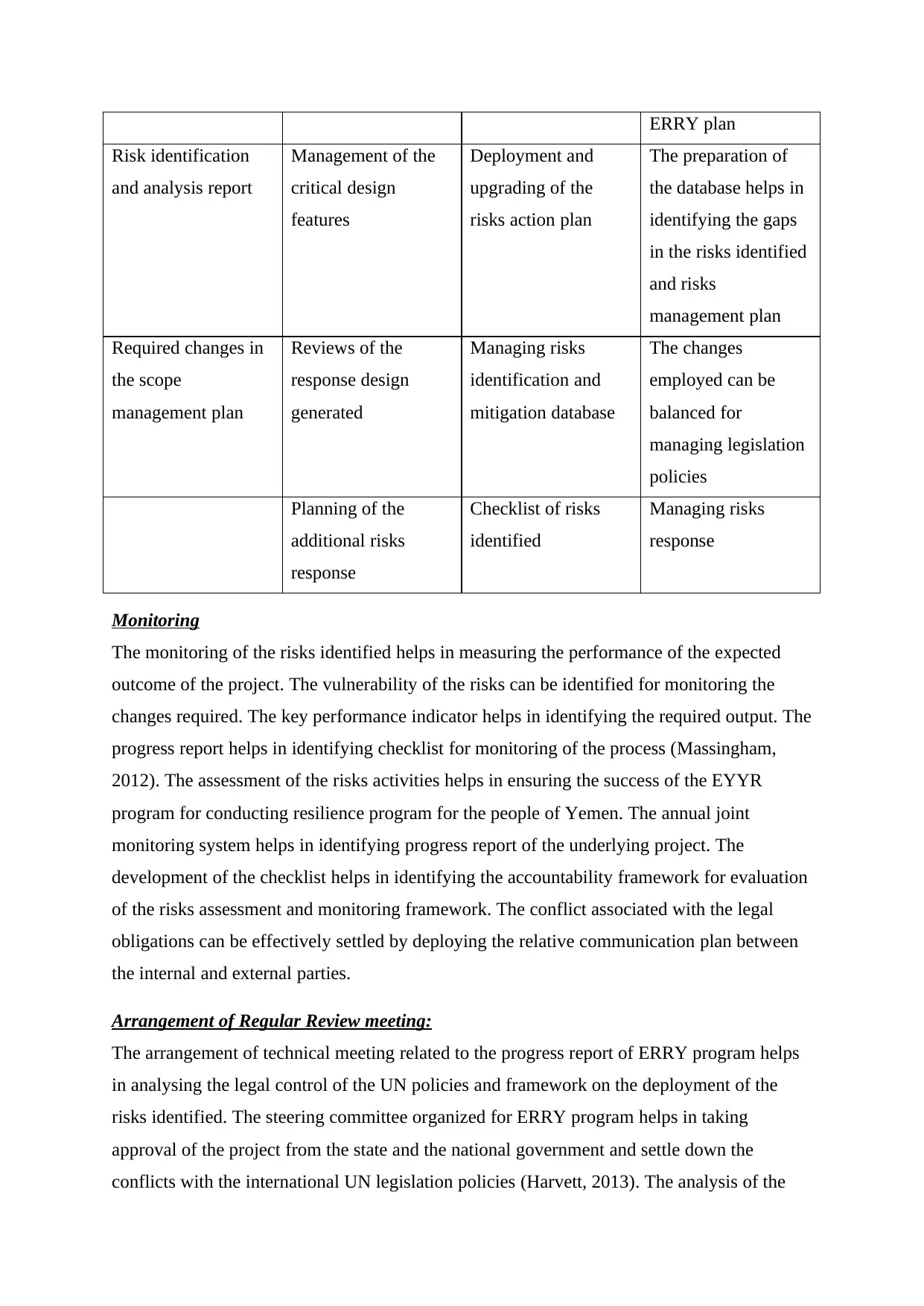
ERRY plan
Risk identification
and analysis report
Management of the
critical design
features
Deployment and
upgrading of the
risks action plan
The preparation of
the database helps in
identifying the gaps
in the risks identified
and risks
management plan
Required changes in
the scope
management plan
Reviews of the
response design
generated
Managing risks
identification and
mitigation database
The changes
employed can be
balanced for
managing legislation
policies
Planning of the
additional risks
response
Checklist of risks
identified
Managing risks
response
Monitoring
The monitoring of the risks identified helps in measuring the performance of the expected
outcome of the project. The vulnerability of the risks can be identified for monitoring the
changes required. The key performance indicator helps in identifying the required output. The
progress report helps in identifying checklist for monitoring of the process (Massingham,
2012). The assessment of the risks activities helps in ensuring the success of the EYYR
program for conducting resilience program for the people of Yemen. The annual joint
monitoring system helps in identifying progress report of the underlying project. The
development of the checklist helps in identifying the accountability framework for evaluation
of the risks assessment and monitoring framework. The conflict associated with the legal
obligations can be effectively settled by deploying the relative communication plan between
the internal and external parties.
Arrangement of Regular Review meeting:
The arrangement of technical meeting related to the progress report of ERRY program helps
in analysing the legal control of the UN policies and framework on the deployment of the
risks identified. The steering committee organized for ERRY program helps in taking
approval of the project from the state and the national government and settle down the
conflicts with the international UN legislation policies (Harvett, 2013). The analysis of the
Risk identification
and analysis report
Management of the
critical design
features
Deployment and
upgrading of the
risks action plan
The preparation of
the database helps in
identifying the gaps
in the risks identified
and risks
management plan
Required changes in
the scope
management plan
Reviews of the
response design
generated
Managing risks
identification and
mitigation database
The changes
employed can be
balanced for
managing legislation
policies
Planning of the
additional risks
response
Checklist of risks
identified
Managing risks
response
Monitoring
The monitoring of the risks identified helps in measuring the performance of the expected
outcome of the project. The vulnerability of the risks can be identified for monitoring the
changes required. The key performance indicator helps in identifying the required output. The
progress report helps in identifying checklist for monitoring of the process (Massingham,
2012). The assessment of the risks activities helps in ensuring the success of the EYYR
program for conducting resilience program for the people of Yemen. The annual joint
monitoring system helps in identifying progress report of the underlying project. The
development of the checklist helps in identifying the accountability framework for evaluation
of the risks assessment and monitoring framework. The conflict associated with the legal
obligations can be effectively settled by deploying the relative communication plan between
the internal and external parties.
Arrangement of Regular Review meeting:
The arrangement of technical meeting related to the progress report of ERRY program helps
in analysing the legal control of the UN policies and framework on the deployment of the
risks identified. The steering committee organized for ERRY program helps in taking
approval of the project from the state and the national government and settle down the
conflicts with the international UN legislation policies (Harvett, 2013). The analysis of the
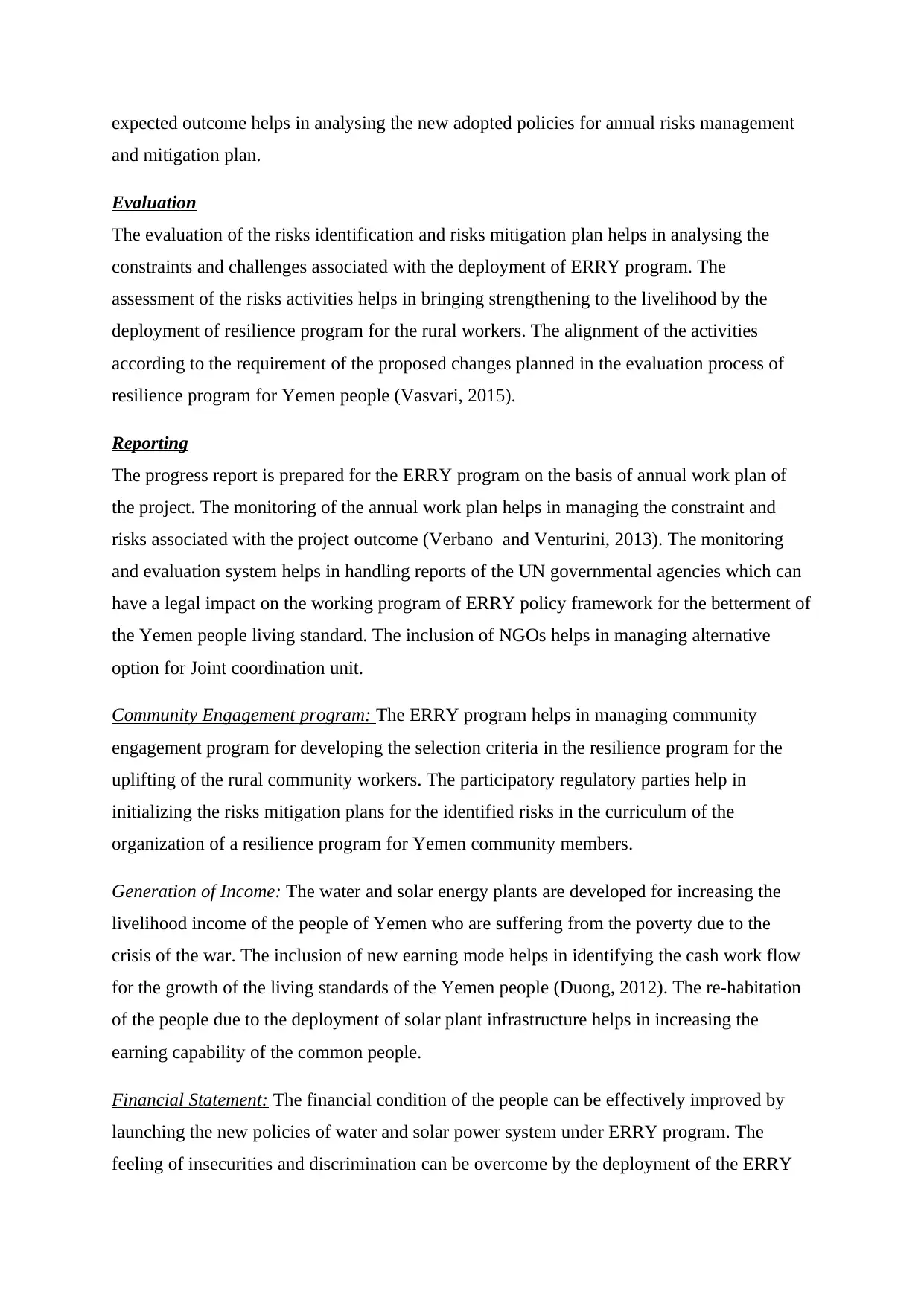
expected outcome helps in analysing the new adopted policies for annual risks management
and mitigation plan.
Evaluation
The evaluation of the risks identification and risks mitigation plan helps in analysing the
constraints and challenges associated with the deployment of ERRY program. The
assessment of the risks activities helps in bringing strengthening to the livelihood by the
deployment of resilience program for the rural workers. The alignment of the activities
according to the requirement of the proposed changes planned in the evaluation process of
resilience program for Yemen people (Vasvari, 2015).
Reporting
The progress report is prepared for the ERRY program on the basis of annual work plan of
the project. The monitoring of the annual work plan helps in managing the constraint and
risks associated with the project outcome (Verbano and Venturini, 2013). The monitoring
and evaluation system helps in handling reports of the UN governmental agencies which can
have a legal impact on the working program of ERRY policy framework for the betterment of
the Yemen people living standard. The inclusion of NGOs helps in managing alternative
option for Joint coordination unit.
Community Engagement program: The ERRY program helps in managing community
engagement program for developing the selection criteria in the resilience program for the
uplifting of the rural community workers. The participatory regulatory parties help in
initializing the risks mitigation plans for the identified risks in the curriculum of the
organization of a resilience program for Yemen community members.
Generation of Income: The water and solar energy plants are developed for increasing the
livelihood income of the people of Yemen who are suffering from the poverty due to the
crisis of the war. The inclusion of new earning mode helps in identifying the cash work flow
for the growth of the living standards of the Yemen people (Duong, 2012). The re-habitation
of the people due to the deployment of solar plant infrastructure helps in increasing the
earning capability of the common people.
Financial Statement: The financial condition of the people can be effectively improved by
launching the new policies of water and solar power system under ERRY program. The
feeling of insecurities and discrimination can be overcome by the deployment of the ERRY
and mitigation plan.
Evaluation
The evaluation of the risks identification and risks mitigation plan helps in analysing the
constraints and challenges associated with the deployment of ERRY program. The
assessment of the risks activities helps in bringing strengthening to the livelihood by the
deployment of resilience program for the rural workers. The alignment of the activities
according to the requirement of the proposed changes planned in the evaluation process of
resilience program for Yemen people (Vasvari, 2015).
Reporting
The progress report is prepared for the ERRY program on the basis of annual work plan of
the project. The monitoring of the annual work plan helps in managing the constraint and
risks associated with the project outcome (Verbano and Venturini, 2013). The monitoring
and evaluation system helps in handling reports of the UN governmental agencies which can
have a legal impact on the working program of ERRY policy framework for the betterment of
the Yemen people living standard. The inclusion of NGOs helps in managing alternative
option for Joint coordination unit.
Community Engagement program: The ERRY program helps in managing community
engagement program for developing the selection criteria in the resilience program for the
uplifting of the rural community workers. The participatory regulatory parties help in
initializing the risks mitigation plans for the identified risks in the curriculum of the
organization of a resilience program for Yemen community members.
Generation of Income: The water and solar energy plants are developed for increasing the
livelihood income of the people of Yemen who are suffering from the poverty due to the
crisis of the war. The inclusion of new earning mode helps in identifying the cash work flow
for the growth of the living standards of the Yemen people (Duong, 2012). The re-habitation
of the people due to the deployment of solar plant infrastructure helps in increasing the
earning capability of the common people.
Financial Statement: The financial condition of the people can be effectively improved by
launching the new policies of water and solar power system under ERRY program. The
feeling of insecurities and discrimination can be overcome by the deployment of the ERRY
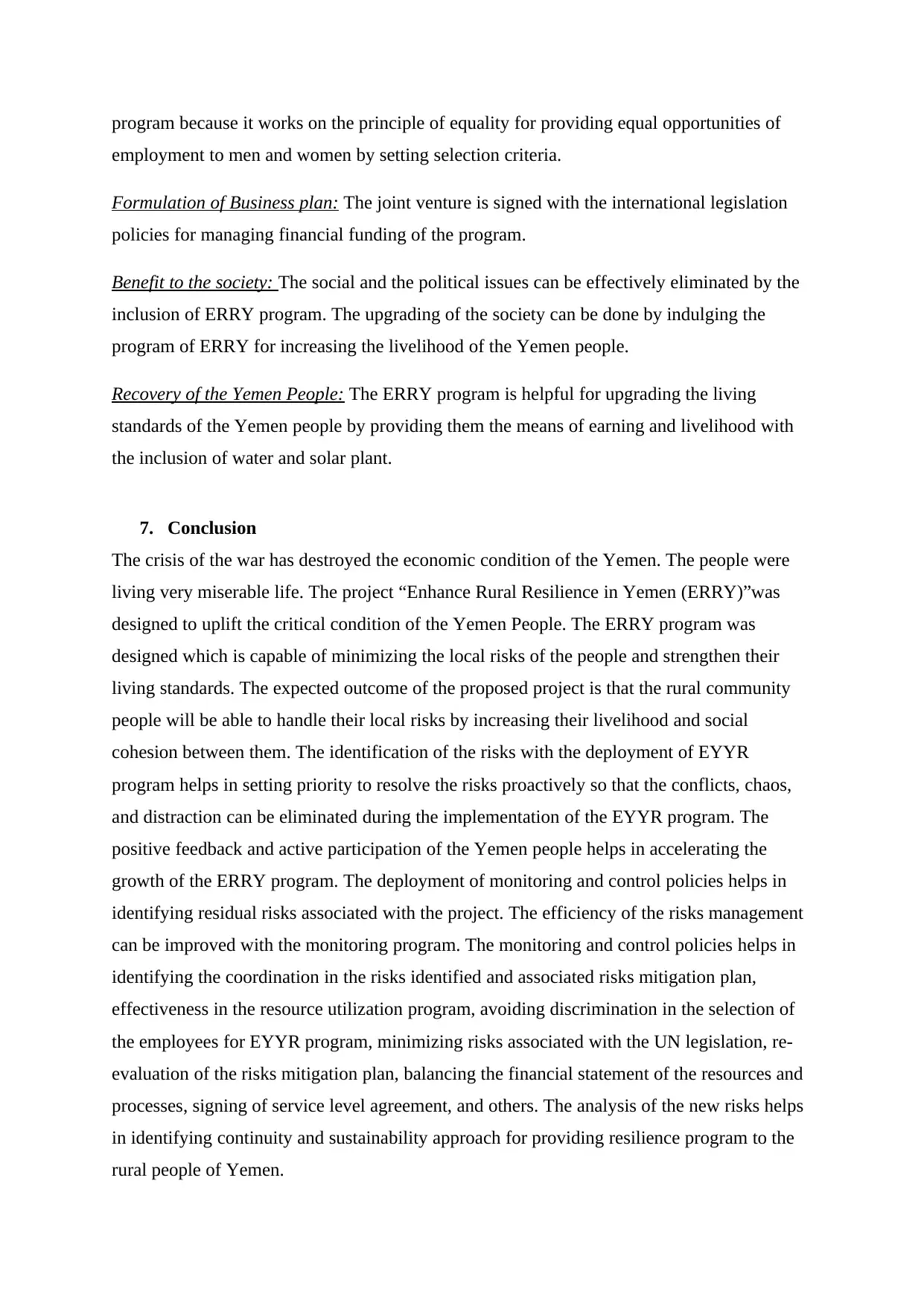
program because it works on the principle of equality for providing equal opportunities of
employment to men and women by setting selection criteria.
Formulation of Business plan: The joint venture is signed with the international legislation
policies for managing financial funding of the program.
Benefit to the society: The social and the political issues can be effectively eliminated by the
inclusion of ERRY program. The upgrading of the society can be done by indulging the
program of ERRY for increasing the livelihood of the Yemen people.
Recovery of the Yemen People: The ERRY program is helpful for upgrading the living
standards of the Yemen people by providing them the means of earning and livelihood with
the inclusion of water and solar plant.
7. Conclusion
The crisis of the war has destroyed the economic condition of the Yemen. The people were
living very miserable life. The project “Enhance Rural Resilience in Yemen (ERRY)”was
designed to uplift the critical condition of the Yemen People. The ERRY program was
designed which is capable of minimizing the local risks of the people and strengthen their
living standards. The expected outcome of the proposed project is that the rural community
people will be able to handle their local risks by increasing their livelihood and social
cohesion between them. The identification of the risks with the deployment of EYYR
program helps in setting priority to resolve the risks proactively so that the conflicts, chaos,
and distraction can be eliminated during the implementation of the EYYR program. The
positive feedback and active participation of the Yemen people helps in accelerating the
growth of the ERRY program. The deployment of monitoring and control policies helps in
identifying residual risks associated with the project. The efficiency of the risks management
can be improved with the monitoring program. The monitoring and control policies helps in
identifying the coordination in the risks identified and associated risks mitigation plan,
effectiveness in the resource utilization program, avoiding discrimination in the selection of
the employees for EYYR program, minimizing risks associated with the UN legislation, re-
evaluation of the risks mitigation plan, balancing the financial statement of the resources and
processes, signing of service level agreement, and others. The analysis of the new risks helps
in identifying continuity and sustainability approach for providing resilience program to the
rural people of Yemen.
employment to men and women by setting selection criteria.
Formulation of Business plan: The joint venture is signed with the international legislation
policies for managing financial funding of the program.
Benefit to the society: The social and the political issues can be effectively eliminated by the
inclusion of ERRY program. The upgrading of the society can be done by indulging the
program of ERRY for increasing the livelihood of the Yemen people.
Recovery of the Yemen People: The ERRY program is helpful for upgrading the living
standards of the Yemen people by providing them the means of earning and livelihood with
the inclusion of water and solar plant.
7. Conclusion
The crisis of the war has destroyed the economic condition of the Yemen. The people were
living very miserable life. The project “Enhance Rural Resilience in Yemen (ERRY)”was
designed to uplift the critical condition of the Yemen People. The ERRY program was
designed which is capable of minimizing the local risks of the people and strengthen their
living standards. The expected outcome of the proposed project is that the rural community
people will be able to handle their local risks by increasing their livelihood and social
cohesion between them. The identification of the risks with the deployment of EYYR
program helps in setting priority to resolve the risks proactively so that the conflicts, chaos,
and distraction can be eliminated during the implementation of the EYYR program. The
positive feedback and active participation of the Yemen people helps in accelerating the
growth of the ERRY program. The deployment of monitoring and control policies helps in
identifying residual risks associated with the project. The efficiency of the risks management
can be improved with the monitoring program. The monitoring and control policies helps in
identifying the coordination in the risks identified and associated risks mitigation plan,
effectiveness in the resource utilization program, avoiding discrimination in the selection of
the employees for EYYR program, minimizing risks associated with the UN legislation, re-
evaluation of the risks mitigation plan, balancing the financial statement of the resources and
processes, signing of service level agreement, and others. The analysis of the new risks helps
in identifying continuity and sustainability approach for providing resilience program to the
rural people of Yemen.
Secure Best Marks with AI Grader
Need help grading? Try our AI Grader for instant feedback on your assignments.
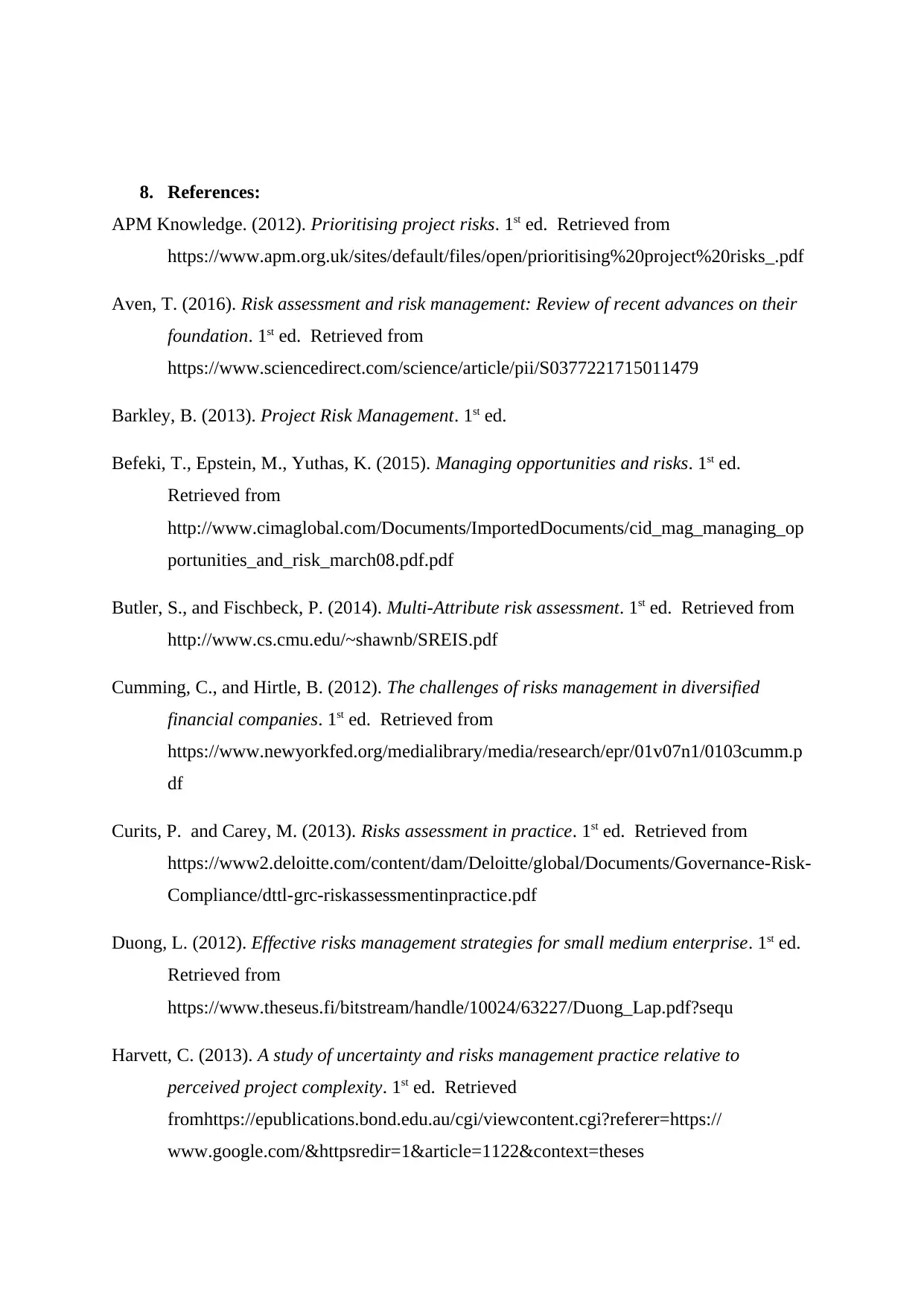
8. References:
APM Knowledge. (2012). Prioritising project risks. 1st ed. Retrieved from
https://www.apm.org.uk/sites/default/files/open/prioritising%20project%20risks_.pdf
Aven, T. (2016). Risk assessment and risk management: Review of recent advances on their
foundation. 1st ed. Retrieved from
https://www.sciencedirect.com/science/article/pii/S0377221715011479
Barkley, B. (2013). Project Risk Management. 1st ed.
Befeki, T., Epstein, M., Yuthas, K. (2015). Managing opportunities and risks. 1st ed.
Retrieved from
http://www.cimaglobal.com/Documents/ImportedDocuments/cid_mag_managing_op
portunities_and_risk_march08.pdf.pdf
Butler, S., and Fischbeck, P. (2014). Multi-Attribute risk assessment. 1st ed. Retrieved from
http://www.cs.cmu.edu/~shawnb/SREIS.pdf
Cumming, C., and Hirtle, B. (2012). The challenges of risks management in diversified
financial companies. 1st ed. Retrieved from
https://www.newyorkfed.org/medialibrary/media/research/epr/01v07n1/0103cumm.p
df
Curits, P. and Carey, M. (2013). Risks assessment in practice. 1st ed. Retrieved from
https://www2.deloitte.com/content/dam/Deloitte/global/Documents/Governance-Risk-
Compliance/dttl-grc-riskassessmentinpractice.pdf
Duong, L. (2012). Effective risks management strategies for small medium enterprise. 1st ed.
Retrieved from
https://www.theseus.fi/bitstream/handle/10024/63227/Duong_Lap.pdf?sequ
Harvett, C. (2013). A study of uncertainty and risks management practice relative to
perceived project complexity. 1st ed. Retrieved
fromhttps://epublications.bond.edu.au/cgi/viewcontent.cgi?referer=https://
www.google.com/&httpsredir=1&article=1122&context=theses
APM Knowledge. (2012). Prioritising project risks. 1st ed. Retrieved from
https://www.apm.org.uk/sites/default/files/open/prioritising%20project%20risks_.pdf
Aven, T. (2016). Risk assessment and risk management: Review of recent advances on their
foundation. 1st ed. Retrieved from
https://www.sciencedirect.com/science/article/pii/S0377221715011479
Barkley, B. (2013). Project Risk Management. 1st ed.
Befeki, T., Epstein, M., Yuthas, K. (2015). Managing opportunities and risks. 1st ed.
Retrieved from
http://www.cimaglobal.com/Documents/ImportedDocuments/cid_mag_managing_op
portunities_and_risk_march08.pdf.pdf
Butler, S., and Fischbeck, P. (2014). Multi-Attribute risk assessment. 1st ed. Retrieved from
http://www.cs.cmu.edu/~shawnb/SREIS.pdf
Cumming, C., and Hirtle, B. (2012). The challenges of risks management in diversified
financial companies. 1st ed. Retrieved from
https://www.newyorkfed.org/medialibrary/media/research/epr/01v07n1/0103cumm.p
df
Curits, P. and Carey, M. (2013). Risks assessment in practice. 1st ed. Retrieved from
https://www2.deloitte.com/content/dam/Deloitte/global/Documents/Governance-Risk-
Compliance/dttl-grc-riskassessmentinpractice.pdf
Duong, L. (2012). Effective risks management strategies for small medium enterprise. 1st ed.
Retrieved from
https://www.theseus.fi/bitstream/handle/10024/63227/Duong_Lap.pdf?sequ
Harvett, C. (2013). A study of uncertainty and risks management practice relative to
perceived project complexity. 1st ed. Retrieved
fromhttps://epublications.bond.edu.au/cgi/viewcontent.cgi?referer=https://
www.google.com/&httpsredir=1&article=1122&context=theses
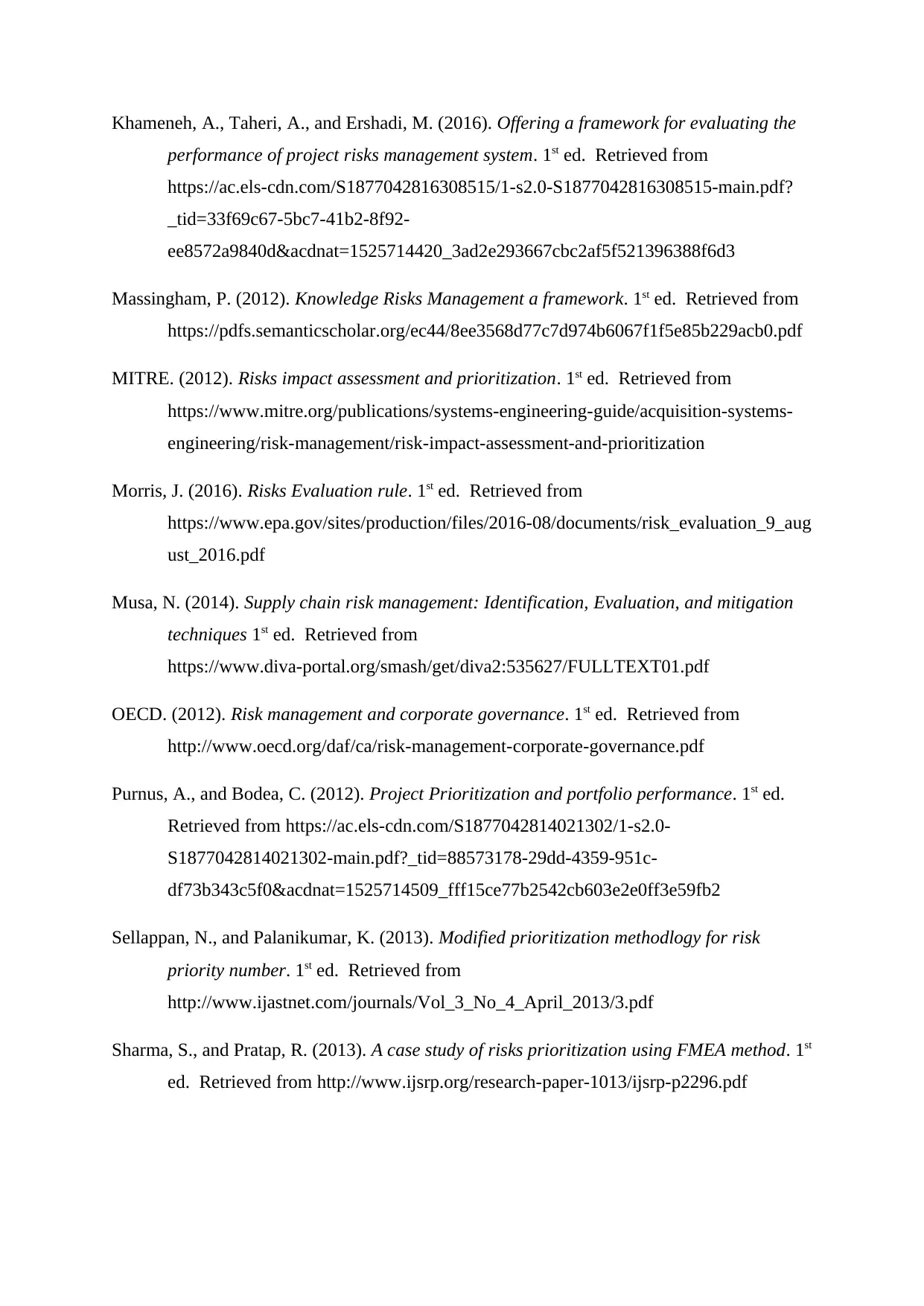
Khameneh, A., Taheri, A., and Ershadi, M. (2016). Offering a framework for evaluating the
performance of project risks management system. 1st ed. Retrieved from
https://ac.els-cdn.com/S1877042816308515/1-s2.0-S1877042816308515-main.pdf?
_tid=33f69c67-5bc7-41b2-8f92-
ee8572a9840d&acdnat=1525714420_3ad2e293667cbc2af5f521396388f6d3
Massingham, P. (2012). Knowledge Risks Management a framework. 1st ed. Retrieved from
https://pdfs.semanticscholar.org/ec44/8ee3568d77c7d974b6067f1f5e85b229acb0.pdf
MITRE. (2012). Risks impact assessment and prioritization. 1st ed. Retrieved from
https://www.mitre.org/publications/systems-engineering-guide/acquisition-systems-
engineering/risk-management/risk-impact-assessment-and-prioritization
Morris, J. (2016). Risks Evaluation rule. 1st ed. Retrieved from
https://www.epa.gov/sites/production/files/2016-08/documents/risk_evaluation_9_aug
ust_2016.pdf
Musa, N. (2014). Supply chain risk management: Identification, Evaluation, and mitigation
techniques 1st ed. Retrieved from
https://www.diva-portal.org/smash/get/diva2:535627/FULLTEXT01.pdf
OECD. (2012). Risk management and corporate governance. 1st ed. Retrieved from
http://www.oecd.org/daf/ca/risk-management-corporate-governance.pdf
Purnus, A., and Bodea, C. (2012). Project Prioritization and portfolio performance. 1st ed.
Retrieved from https://ac.els-cdn.com/S1877042814021302/1-s2.0-
S1877042814021302-main.pdf?_tid=88573178-29dd-4359-951c-
df73b343c5f0&acdnat=1525714509_fff15ce77b2542cb603e2e0ff3e59fb2
Sellappan, N., and Palanikumar, K. (2013). Modified prioritization methodlogy for risk
priority number. 1st ed. Retrieved from
http://www.ijastnet.com/journals/Vol_3_No_4_April_2013/3.pdf
Sharma, S., and Pratap, R. (2013). A case study of risks prioritization using FMEA method. 1st
ed. Retrieved from http://www.ijsrp.org/research-paper-1013/ijsrp-p2296.pdf
performance of project risks management system. 1st ed. Retrieved from
https://ac.els-cdn.com/S1877042816308515/1-s2.0-S1877042816308515-main.pdf?
_tid=33f69c67-5bc7-41b2-8f92-
ee8572a9840d&acdnat=1525714420_3ad2e293667cbc2af5f521396388f6d3
Massingham, P. (2012). Knowledge Risks Management a framework. 1st ed. Retrieved from
https://pdfs.semanticscholar.org/ec44/8ee3568d77c7d974b6067f1f5e85b229acb0.pdf
MITRE. (2012). Risks impact assessment and prioritization. 1st ed. Retrieved from
https://www.mitre.org/publications/systems-engineering-guide/acquisition-systems-
engineering/risk-management/risk-impact-assessment-and-prioritization
Morris, J. (2016). Risks Evaluation rule. 1st ed. Retrieved from
https://www.epa.gov/sites/production/files/2016-08/documents/risk_evaluation_9_aug
ust_2016.pdf
Musa, N. (2014). Supply chain risk management: Identification, Evaluation, and mitigation
techniques 1st ed. Retrieved from
https://www.diva-portal.org/smash/get/diva2:535627/FULLTEXT01.pdf
OECD. (2012). Risk management and corporate governance. 1st ed. Retrieved from
http://www.oecd.org/daf/ca/risk-management-corporate-governance.pdf
Purnus, A., and Bodea, C. (2012). Project Prioritization and portfolio performance. 1st ed.
Retrieved from https://ac.els-cdn.com/S1877042814021302/1-s2.0-
S1877042814021302-main.pdf?_tid=88573178-29dd-4359-951c-
df73b343c5f0&acdnat=1525714509_fff15ce77b2542cb603e2e0ff3e59fb2
Sellappan, N., and Palanikumar, K. (2013). Modified prioritization methodlogy for risk
priority number. 1st ed. Retrieved from
http://www.ijastnet.com/journals/Vol_3_No_4_April_2013/3.pdf
Sharma, S., and Pratap, R. (2013). A case study of risks prioritization using FMEA method. 1st
ed. Retrieved from http://www.ijsrp.org/research-paper-1013/ijsrp-p2296.pdf
1 out of 24
Your All-in-One AI-Powered Toolkit for Academic Success.
+13062052269
info@desklib.com
Available 24*7 on WhatsApp / Email
![[object Object]](/_next/static/media/star-bottom.7253800d.svg)
Unlock your academic potential
© 2024 | Zucol Services PVT LTD | All rights reserved.
